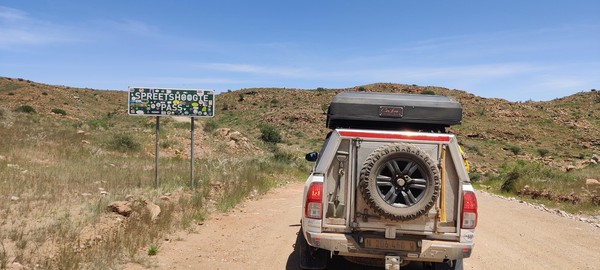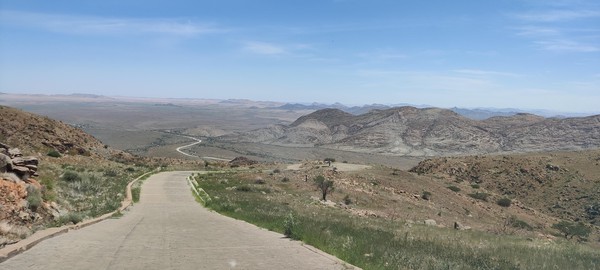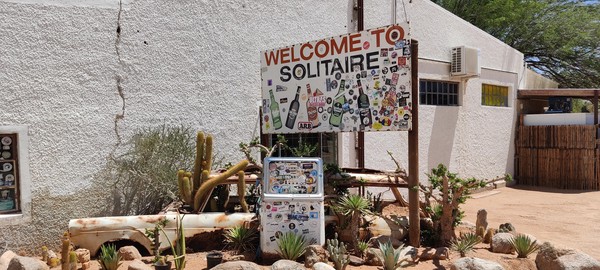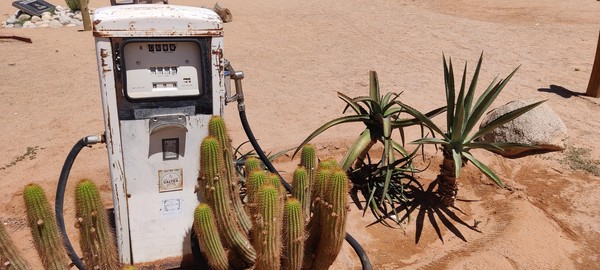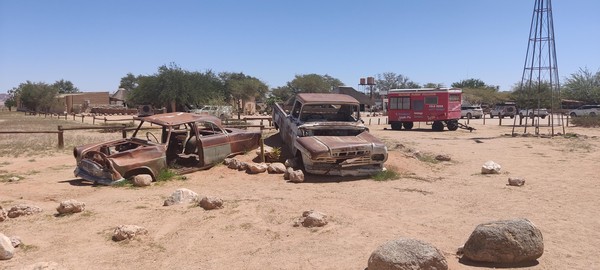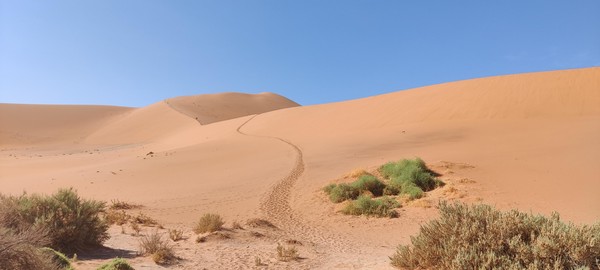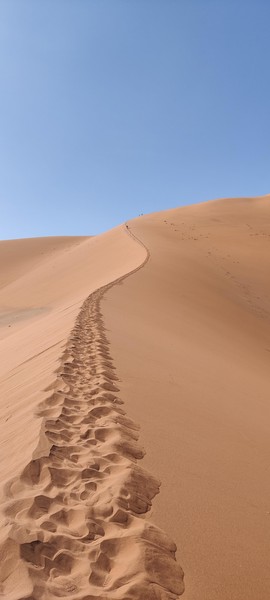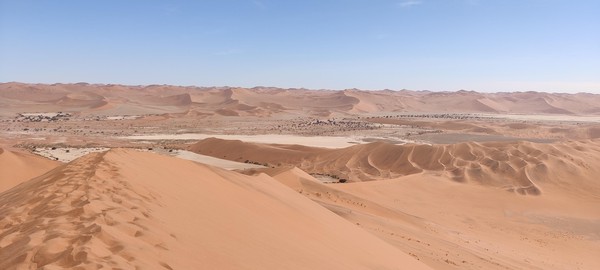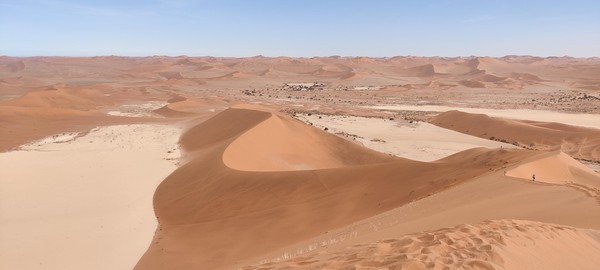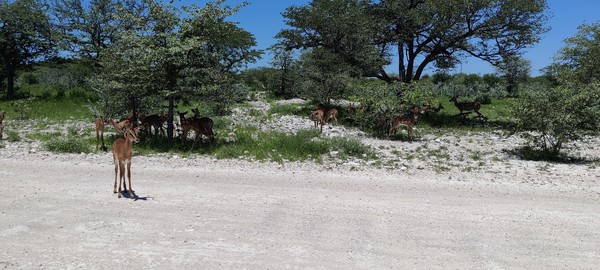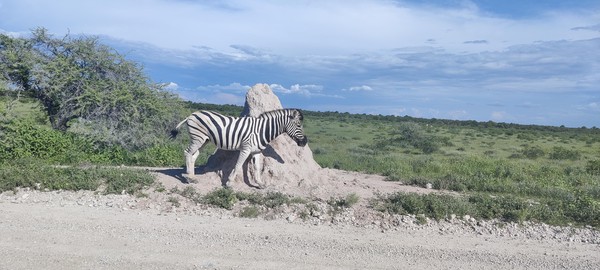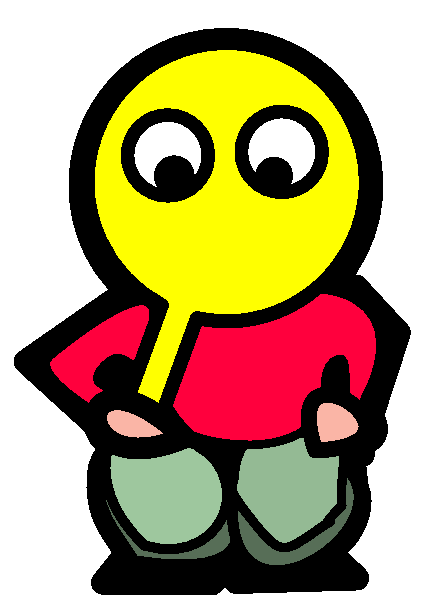The Gem of Africa
March 25, 2025 | 8,687 words | 41min read
A year ago, a friend of mine had the idea to visit Namibia—often referred to as the “Gems of Africa” because of its diversity of animals and biomes. I’m not entirely sure how he came up with the idea. Maybe it was due to the country’s connection to Germany during its colonial period, or perhaps some algorithmic push from the “machine gods” in his feed. Whatever the reason, he asked our friend group if we were up for joining him. Another friend said yes, but I couldn’t go because it overlapped with some exams I had to take at university. However, I promised him that next semester, I would choose modules that allowed me to have some free time, which would overlap with theirs.
Luckily, our friend group is relatively small—just me and the other two. We go back to kindergarten, all being from the same village, so synchronizing our schedules was easier. Still, there were some problems because the others are at different universities, meaning our semesters don’t neatly overlap. Their exam phase finishes before mine even starts, and by the time my exams are over, they’re already a few weeks into their next semester.
So, my plan was to move one major exam to my final semester, which would also be the time I’d be writing my bachelor’s thesis. In this semester, I would have two early exams and a few later ones, with a big break in between that I could use for the holiday. My second early exam was on Thursday, and we would fly out on Friday. We spent two weeks in Namibia and flew back. This second exam was in Optimization Theory (see Optimization Theory and More Optimization Problems), which I had already failed once. This exam became my “last try,” and it would come back to bite me—more on that later.
Back to Namibia. The plan was to rent a car and drive in a big circle around the country, checking out all the important sights along the way. We decided to rent an automatic 4x4. Our selection criteria were simple: cheap, reliable, and with a rooftop tent for safety, as Namibia is famous for its wildlife. For food, we stocked the car’s included mini-fridge with cans and bought some game meat from a local butcher. We also bought water in bulk (about 40 liters, calculating 5 liters per person per day), as it’s not safe to drink in most places. We spent most nights at rented campsites, where we could grill the game meat and canned food in the evening. For dinner, we often had bread and cheese. When we were in a city, we took the opportunity to stay in a hotel and eat at a restaurant.
Before the trip, we had some preparations to do, the most important being a visit to the travel medicine consultation. These can be found in major cities, such as Karlsruhe, and they’ll tell you what you need to know about medical precautions. For example, they recommended vaccinations like rabies, typhus, hepatitis A, tetanus, whooping cough, and diphtheria. Some of these cost money, but my health insurance reimbursed me for the ones that did.
We also bought the meat in advance, rented the car, and booked accommodation for the busier spots, like the Etosha National Park and the city of Swakopmund. It’s important to note that we traveled in the off-season. While this made many things cheaper and less crowded, it also meant fewer animals to see. This is because, in the off-season, there’s a lot of rain, which spreads the animals out. In the peak season, it’s drier, so the animals gather around the waterholes, making it easier to see them—you just have to wait at the waterhole for them to come.
Day 0: The Flight
Our plane took off in the evening, flying directly from Frankfurt to Windhoek, the capital city of Namibia, taking approximately 10 hours. We arrived a bit early, giving us enough time to grab something to eat and, of course, enjoy a beer.
The plane wasn’t large; it could host maybe a hundred people. As this was my first flight, I was a bit nervous, and the turbulence—though not major—didn’t help. To make matters worse, I got the worst seat possible, right in the middle. To my left were my two friends, and to my right was a stranger. This meant that, if I wanted to stand up, I had to either ask the person next to me or get both of my friends to stand up. Before the in-flight meal, this wasn’t much of a problem, but afterward, both my friends and the stranger quickly fell asleep, leaving me to deal with the rest of the night. I spent it trying to suppress the urge to pee and debating whether to wake someone up to use the toilet. I do have a weak bladder, so I barely slept—only about an hour—which would catch up with me the next day.
Aside from that, the flight was rather uneventful, and we arrived safely the following morning.
.jpg)
Day 1: Windhoek
We arrived at 9 o’clock in the morning. The sun was shining at full force, and it was hot. Namibia is extremely diverse in its biomes, which means the temperature can vary a lot, but at this time of year, you can expect temperatures not to drop below 15°C and to rise up to 30°C.

An interesting note about the airport: first, it was crawling with some kind of beetle-like insect; second, right next to the check-in counter was a shrine for Namibia’s first president, who had passed away just two weeks prior to our arrival. He was famous for leading Namibia to independence from South Africa. The shrine included a picture of him, some candles, and a book where people could write messages for him. We would encounter many such shrines during our travels, and hear once more about the complicated relationship between Namibia and South Africa from a local.
The first thing we did was exchange some money for Namibian dollars and buy some water. Here’s a funny thing: there were two local money exchanges right next to each other, with one offering a better rate than the other. How does that work? The company from which we rented the jeep had sent someone to pick us up from the airport, which is a common practice for car rental companies in Namibia. After all, how are you supposed to get to your car otherwise? They don’t have public transportation, and the airport is over an hour’s drive from the next major city, Windhoek. So, we and a bunch of other travelers got onto a bus, which drove us toward the rental company. The bus was speeding down the road, which we later learned is more the norm than the exception. While zipping across the landscape, we took in our first views of Namibia’s scenery, all while the bus driver blasted some kind of African music—lots of dynamic drums. The coolest thing I saw (though I didn’t manage to take a photo) was a monkey sitting on top of a city sign, eating some kind of fruit.
As we entered a more urban environment, it became clear that this is a low-trust society. Every so often, you could spot a neighborhood watch sign. Every property was walled in, often with metal spikes or barbed wire on top of the walls—no ordinary barbed wire, but the NATO-style wire with sharp metal blades instead of spikes.
After arriving at the rental company, we were given a safety briefing, signed some papers, and our journey could finally begin.
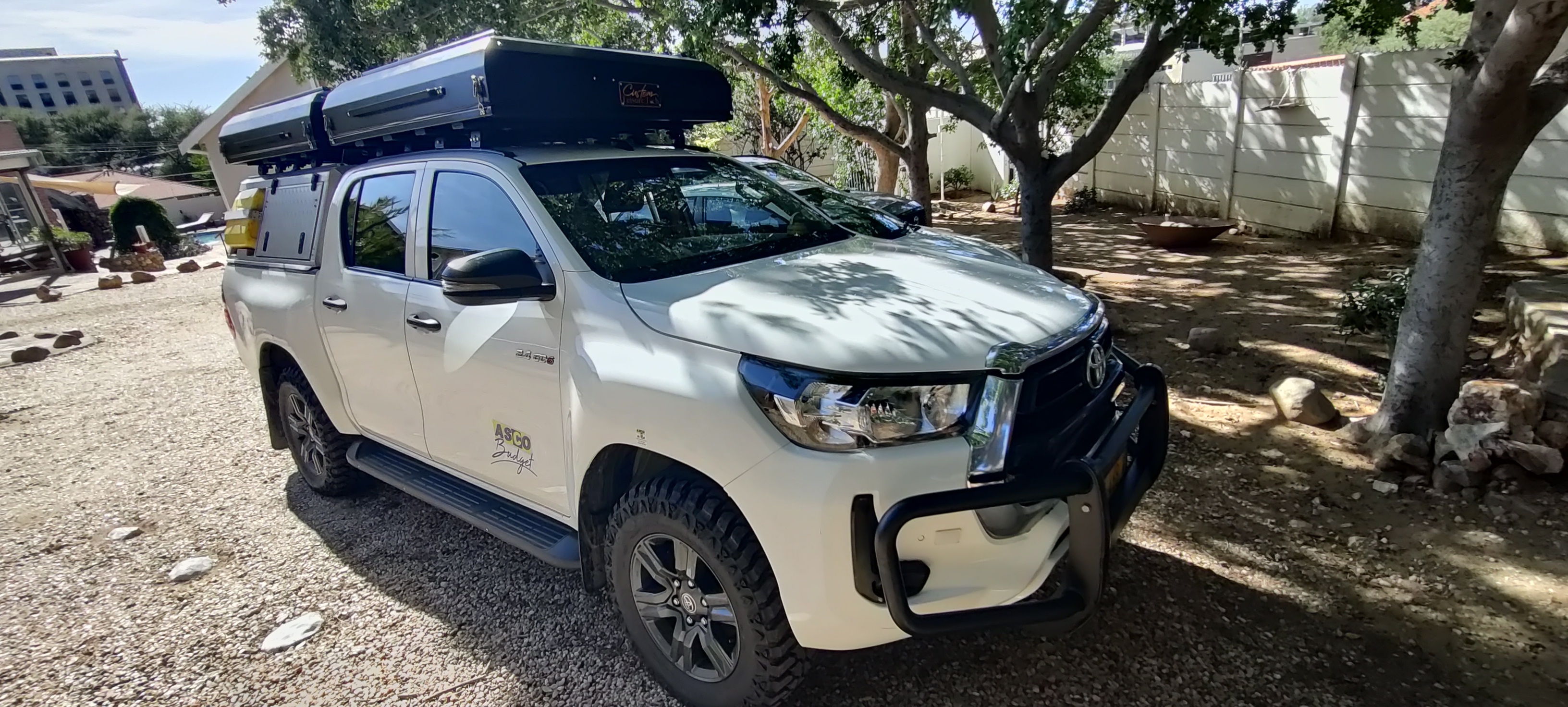
But first, we needed to stock up on supplies, so we went to a supermarket called Superspar (yes, really). As I mentioned earlier, Namibia has a low-trust society, so you’ll find people wearing vests at many parking lots. They’ll watch over your car in exchange for a tip (around 5 Namibian dollars, see here), ensuring nothing gets stolen. Just like at the airport, there was another shrine for the late president in front of the supermarket.
After we finished our shopping, there were five people helping us: one sales associate, two packing our items into bags, and another helping to bring the bags to our car (totally over the top). At that time, we weren’t sure how much to tip, so my friend just handed them a 50 Namibian dollar note. Later, we learned you’re supposed to tip about 5 Namibian dollars. We still had some missing items to buy, so we went to the bazaar, where we picked up SIM cards (10€ for 20GB) and a bunch of water (50 liters). You should calculate about 5 liters per person per day, as the water in Namibia is generally not safe to drink—though it can be used for washing or when boiled.
I have to say, driving in the city is a nightmare, and our nerves were on edge. Remember, I was running on fumes with just an hour of sleep, and on top of that, it was a new car, new traffic rules, and an unfamiliar traffic culture. In retrospect, what we did was crazy. The rental company didn’t really explain the traffic rules, and we didn’t bother to look them up. So, we drove through the city without knowing any of the rules. For example, at a 4-way intersection, there are 12 traffic lights—three for each direction. When we arrived at our first 4-way, we had no idea which light to follow, and unfortunately, there wasn’t even a car in front of us that we could follow. So, we just winged it, which included driving in the middle of the intersection, waiting for cars to pass by, and then making our turn, still in the middle of the intersection.
Naturally, there was a bit of yelling on all sides. The friend who was driving in the city vowed never to drive there again. In general, the traffic rules are strange (at least how I understood them): cars on the main road always have the right of way. Unlike in Germany, you don’t look at the traffic light on your street, but at the light on the opposite street. Each direction has a light for driving straight, one for left turns, and one for right turns. There’s also no “priority to the right” rule. Instead, the vehicle that reaches the intersection first has the right of way, and if that doesn’t work, drivers use eye contact and hand gestures. This leads, as you can imagine, to nerve-wracking traffic behavior in the city.
We finally reached the hotel at 17:00. We had planned to go to the restaurant “Joe’s Beerhouse.” The instructor from the rental company told us that if we weren’t there, we wouldn’t really be experiencing Windhoek. But we were so exhausted that we decided to have a quiet evening and eat at the hotel instead.
Day 2: Driving, Mountain Pass, and Apple Pie
Namibia is a rather dry country, so vegetables and fruits play a lesser role in their cuisine. More importantly, game meat (meat from wild animals rather than domesticated ones) is a staple. We had the idea to buy some meat from a local butcher to grill during our holiday. The butcher kindly brought it to our hotel. The meat included: gnu, springbok, zebra, oryx, eland, and biltong (dried, cured meat that can be eaten as a snack). We were basically eating our way through Namibia’s wildlife. The situation in Namibia can be summarized as:
By giving game value, it encourages farmers to protect them rather than simply driving them off their land. Oryx and eland are not seen as competition for cattle or sheep, but as another type of livestock. The animals are being killed for meat, yes, but the value placed on them encourages everyone to work toward their conservation.
The day began with breakfast, and the highlight was game meat sausage, which had a beefy, gamey taste. We met another German tourist who was on holiday. After realizing it was our first time in Namibia, he gave us some helpful tips. One story I remember was about his fishing trip along the coast, where he caught a fish 1.5 meters long, which was a mixture of shark and ray.
He also told us not to have high hopes for seeing animals in Etosha National Park. He and his friends hadn’t seen any elephants. We kind of expected that, because we were visiting during the off-season. The advantage was that it was cheaper, but the downside was fewer animals. However, we remained hopeful because it had rained a lot two weeks prior, and where there’s water, there’s life—meaning animals.
Then, it was time to hit the road. We packed our things into the jeep and just started driving. Driving in the city is very stressful, but once we were out on the broad, open roads, it finally felt like a holiday. The roads were empty, with views of mountains and nature around us. I played navigator, looking at Google Maps and telling the driver when to turn. We decided to only use Google Maps in the cities, and for the rest of the trip, we relied solely on the map we purchased and street signs.
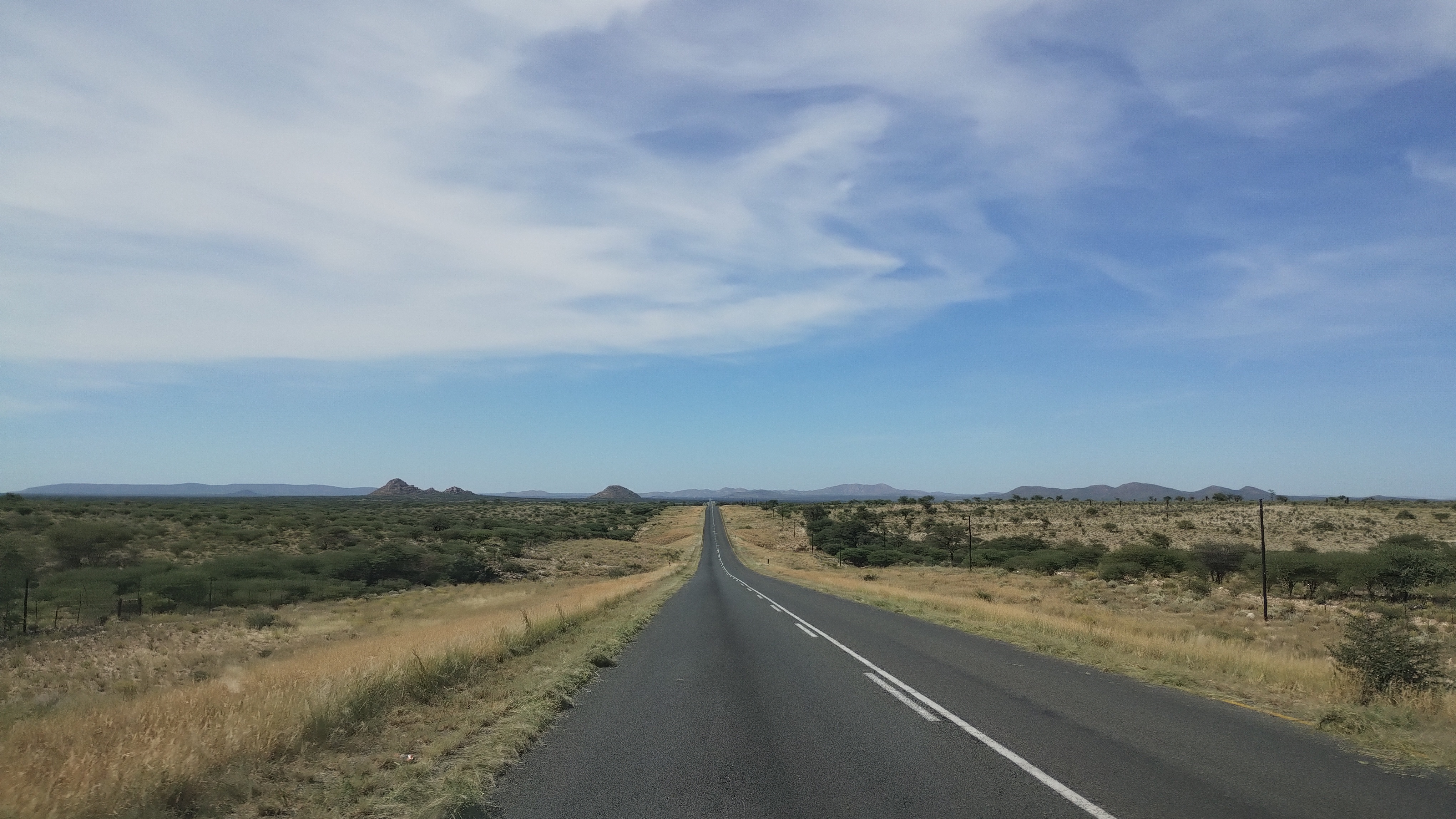
Every street is classified into four levels: A, B, C, and D, indicating how well-maintained they are. Major highways (level A) are always made of asphalt, while other roads (C and below) are gravel. Until now, we had only driven on major highways (asphalt), but that soon changed when we switched from the A1 from Windhoek to Rehoboth to the C24.
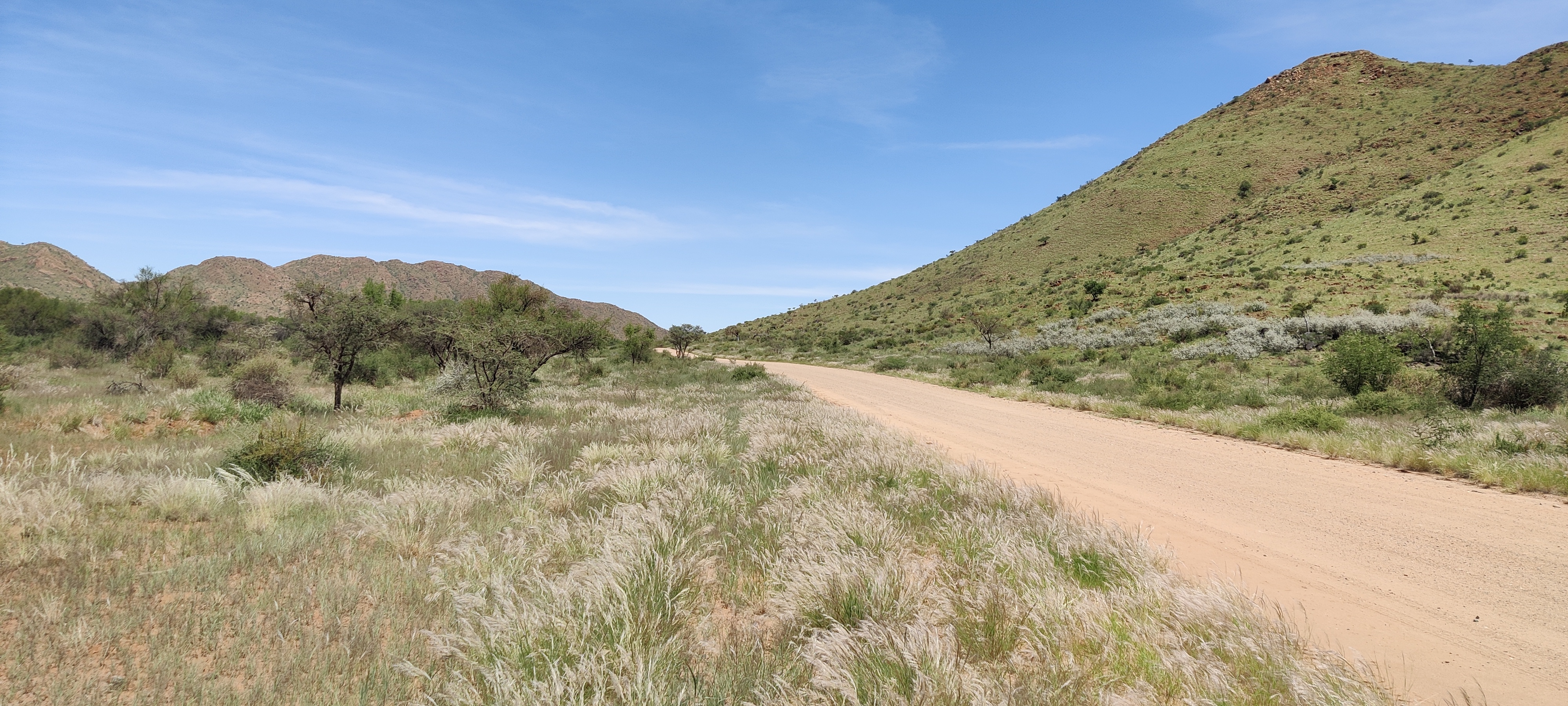
Importantly, when transitioning from an asphalt to a gravel road, you need to adjust the tire pressure. We originally had it at 2.5 kPa and changed it to 2 kPa. While we were doing this, some people drove by, checking to see if we needed help. We signaled that we didn’t, but they stopped anyway and advised us that if we had a flat tire, we should turn back because the road would only get worse. When we explained we were just letting out some pressure, one of them said, “Not everyone in Namibia is a rober, just because you’re European.” It felt like a racism accusation. But better safe than sorry, I thought. I also took the opportunity to take a leak—I couldn’t leave Namibia without at least peeing against one tree!
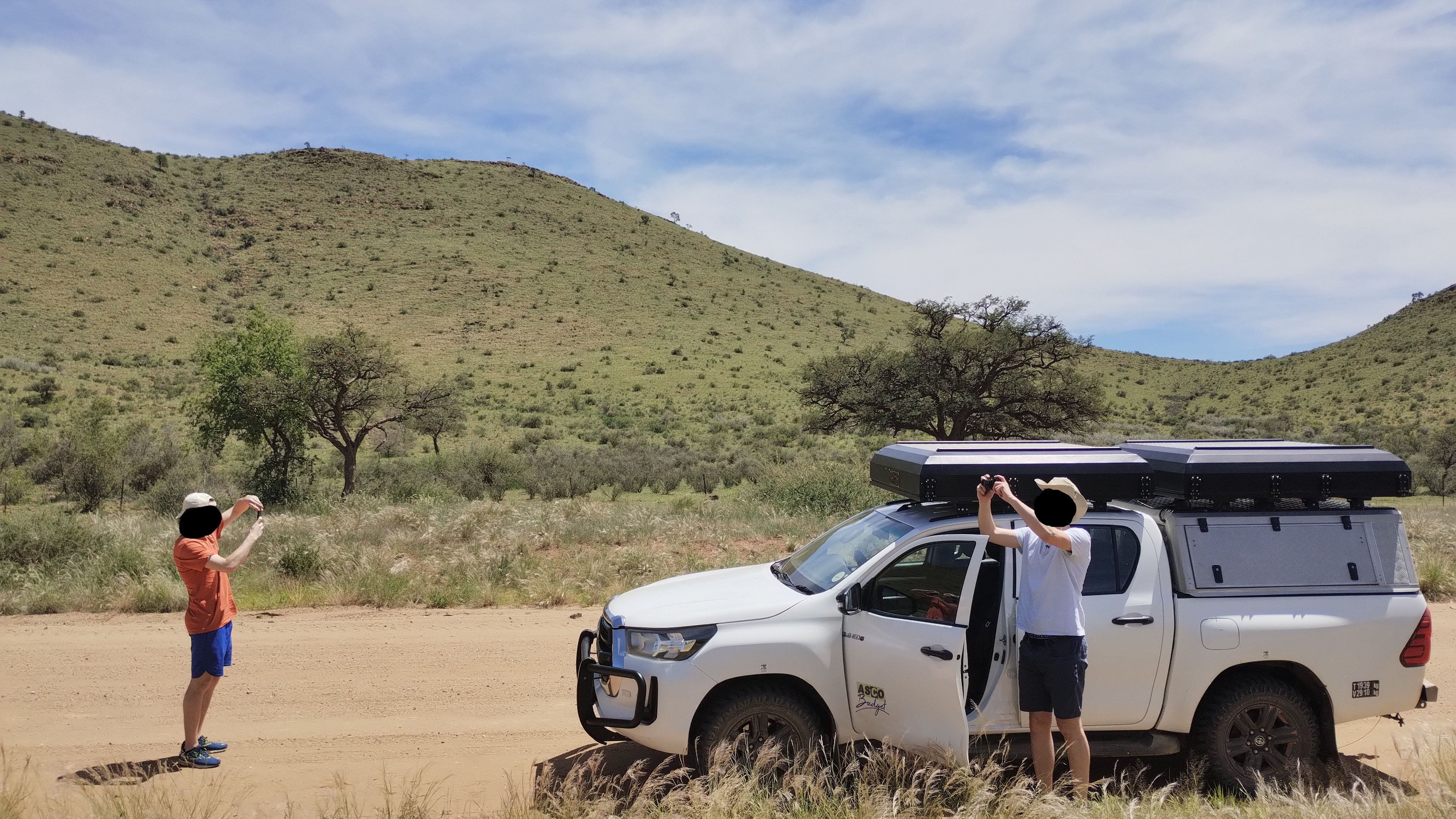
When driving off major highways, the amount of traffic is incredibly low. Later, when using the D1261 road, there were stretches where you could drive for 20 minutes without seeing a single car. And if you did see a car, you could spot it from a distance because the region is flat, with no trees or anything obstructing the view. Even if you couldn’t see the car, you could always spot the giant dust cloud it created in the distance—depending on how much it had rained and how dusty the road was (this particular road was very dusty). When a car passed us, for the next five seconds, we couldn’t see anything due to the dust it stirred up.
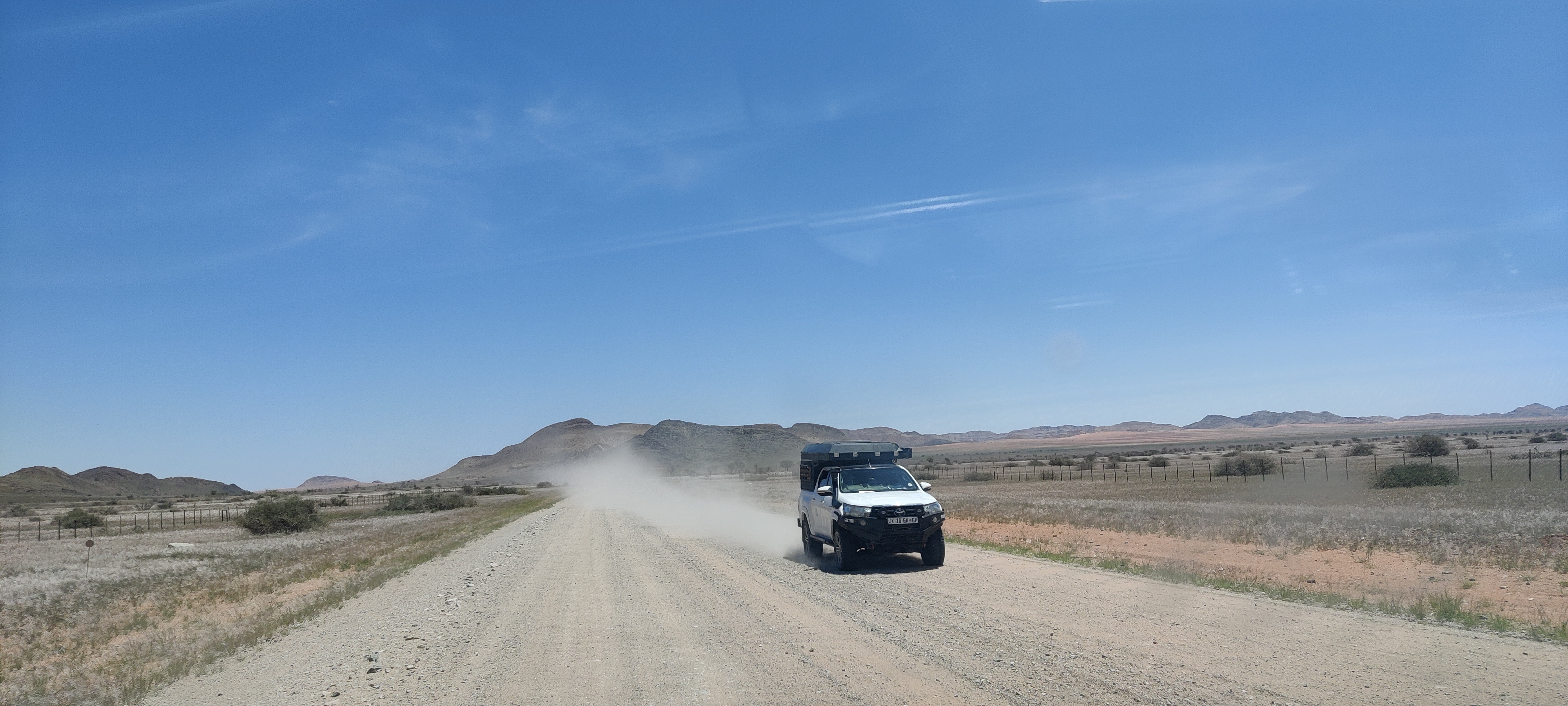
Driving on the D1275, the number of butterflies was incredible. They were constantly flying in front of the car, fluttering away when we got too close, and some of them inevitably slammed into the windshield with a loud thud. One reason we chose this route was because it passed through the Spreetshoogte Mountain Pass, which I highly recommend. The views are spectacular, and the drive itself is quite interesting.
After encountering the C14, we drove to a small village called “Solitaire.” As you can guess by the name, the village is quite desolate, with only a few buildings in the middle of nowhere. However, it’s famous for two things: its McGregor apple pie and its collection of broken, rusty old cars, giving it a vibe straight out of a video game.
When we got on the C19 road, it was the first time I drove the car—before that, my friends had been driving. It took me a while to get used to it since I had never driven an automatic car before. But after a while, it basically drove itself. The roads were in pretty good condition, and we drove for tens of kilometers without turning. We blasted some music, for which we had started collecting songs a year prior specifically for a Namibia road trip playlist. During the 2 hours I drove, I saw five cars (I counted).
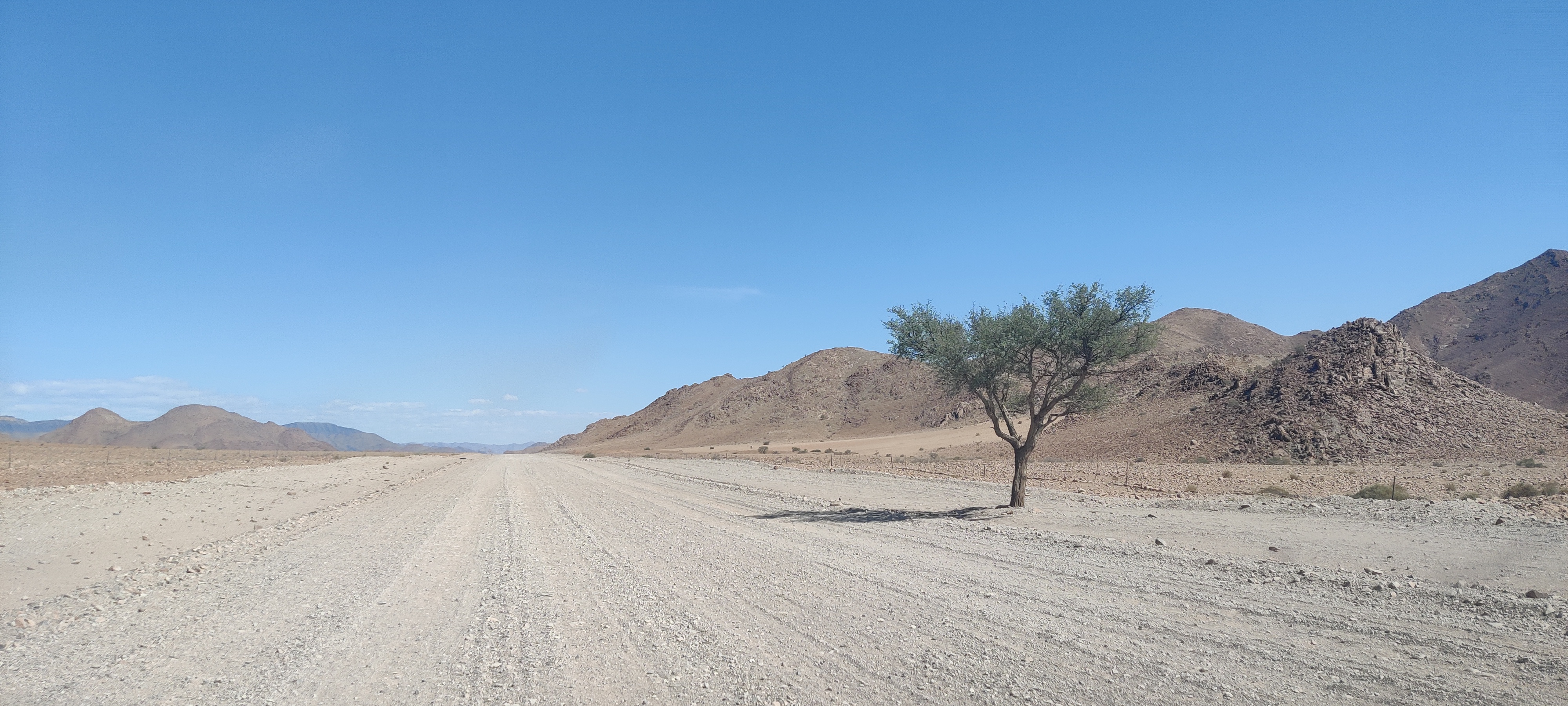
We arrived at “Little Sossus” (haha, “Sus”), a campsite that consisted of several lots with concrete cubicles where we could go to the toilet, shower, and grill. However, there were no beds, so we slept in tents on top of our jeep.
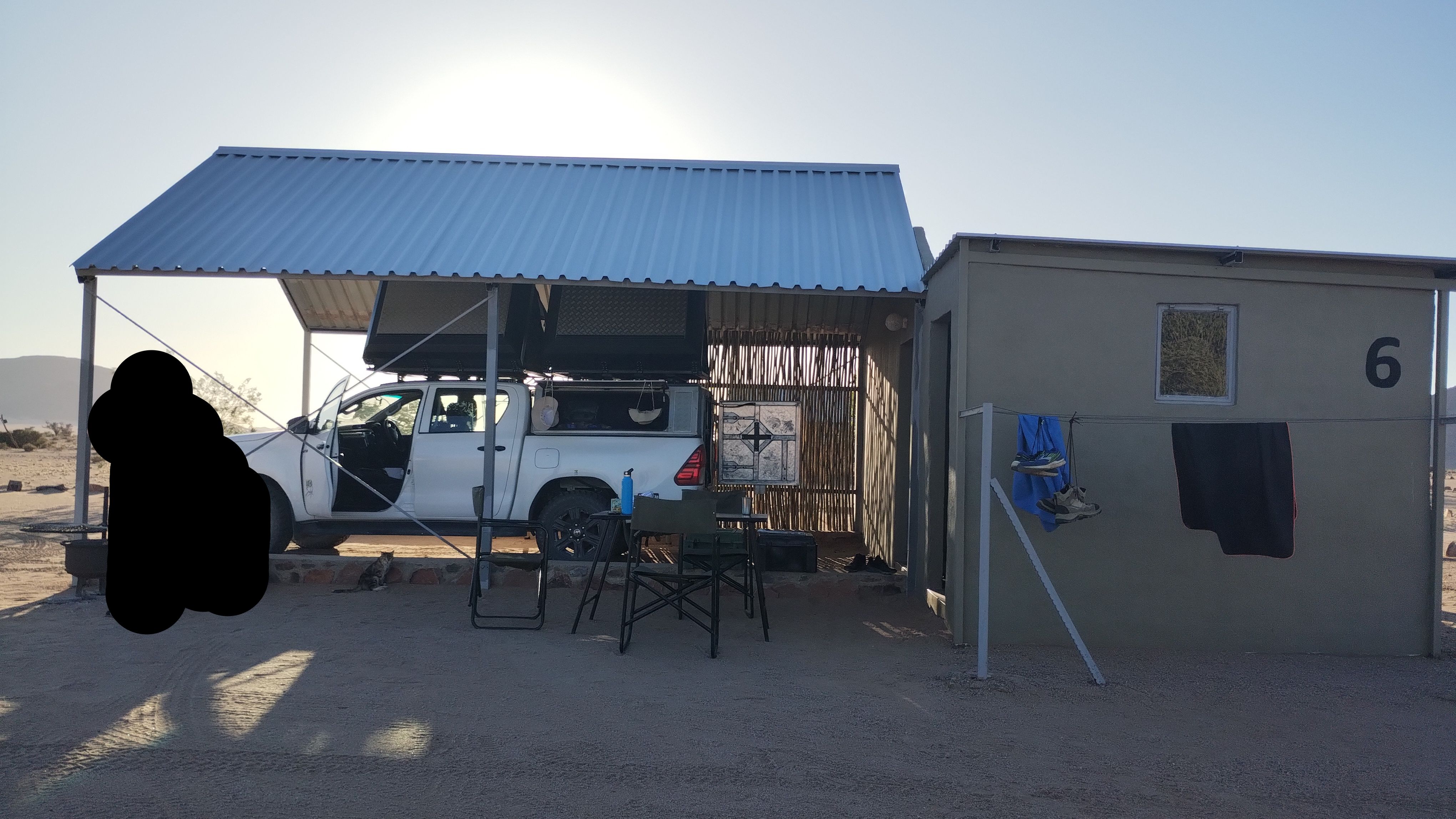
The cubicle seemed to be inhabited by a little fellow, a cat, which for the rest of the day and the next day never left our sides. It lounged in the sand and caught insects that were attracted to our lights in the evening. Well, “caught” might be an exaggeration, as the cat just waited for the insects to come near and then bit them.
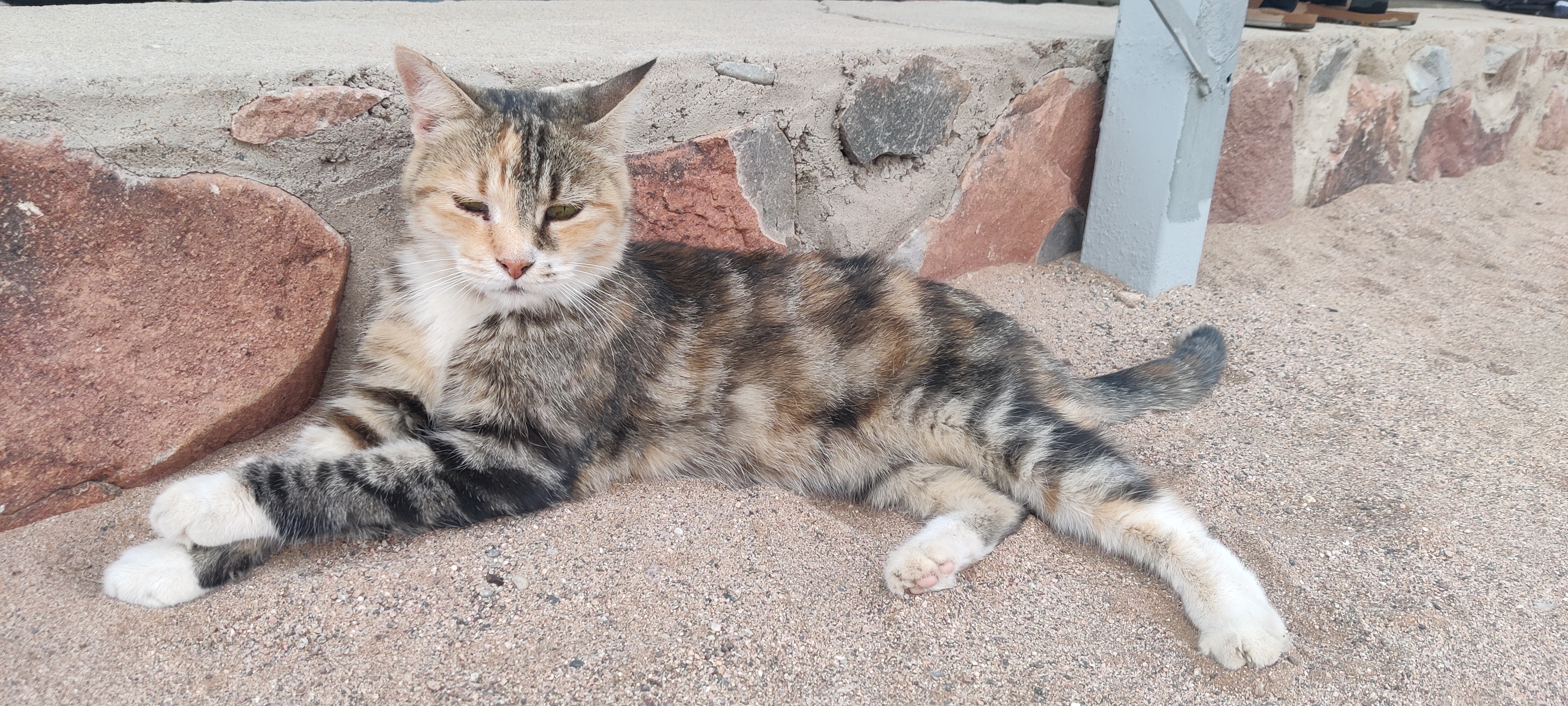
The campsite also had a pool, which I wasn’t expecting because it was in the middle of the desert. The sun was shining at full force, and it was above 30°C. That the water didn’t evaporate seemed like a miracle to me, but maybe they filled it up daily. Relaxing in the pool with the backdrop of a mountain was divine.
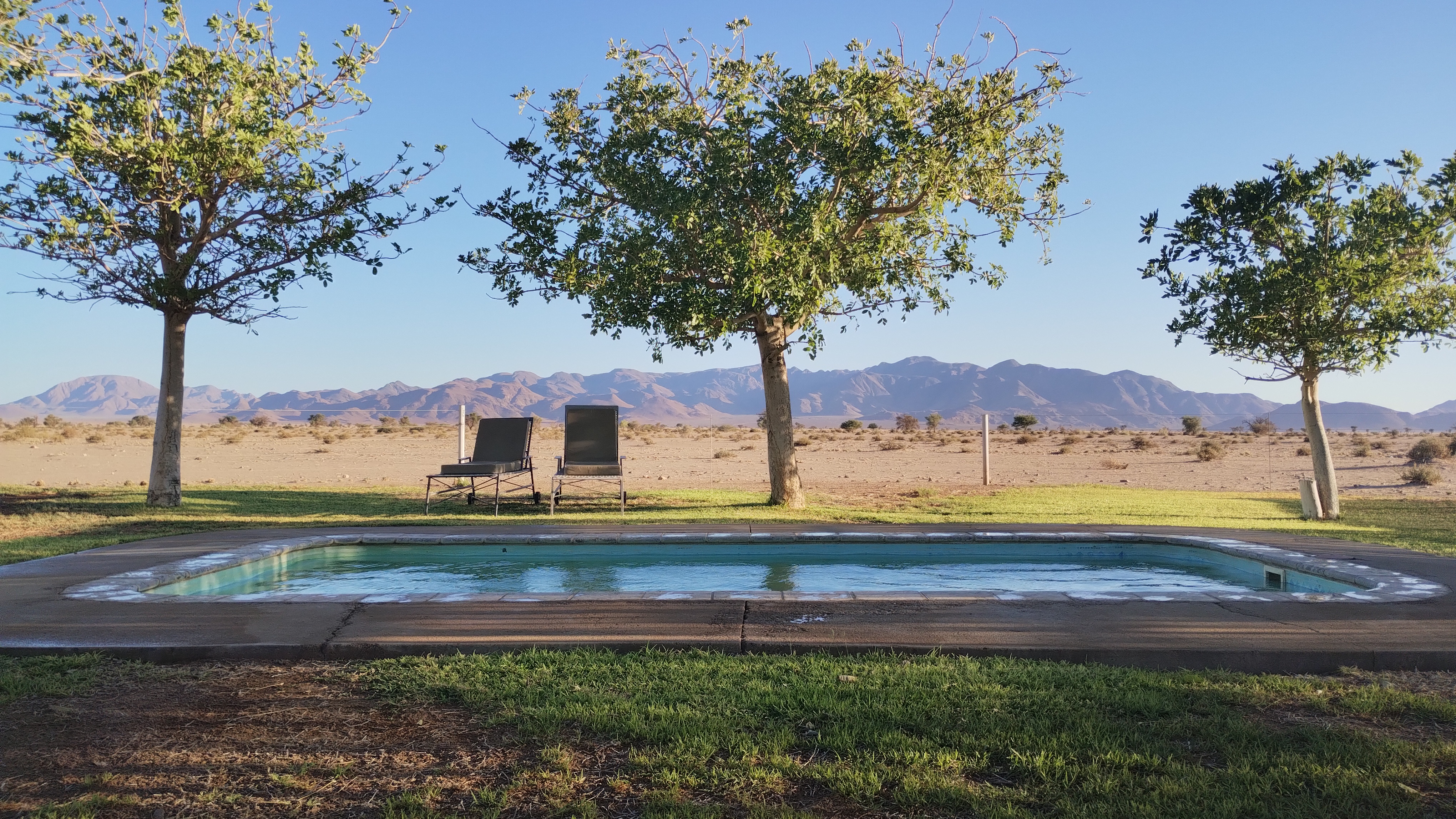
For dinner, we grilled some oryx meat and made some pumpkins (gem squash). We wrapped them in aluminum foil and threw them in the fire. A bit of herb butter, and they were delicious. We let the day fade out with a couple of beers, staring at the night sky. The number of stars was massive, and they were so clear and bright that some of them looked unreal.
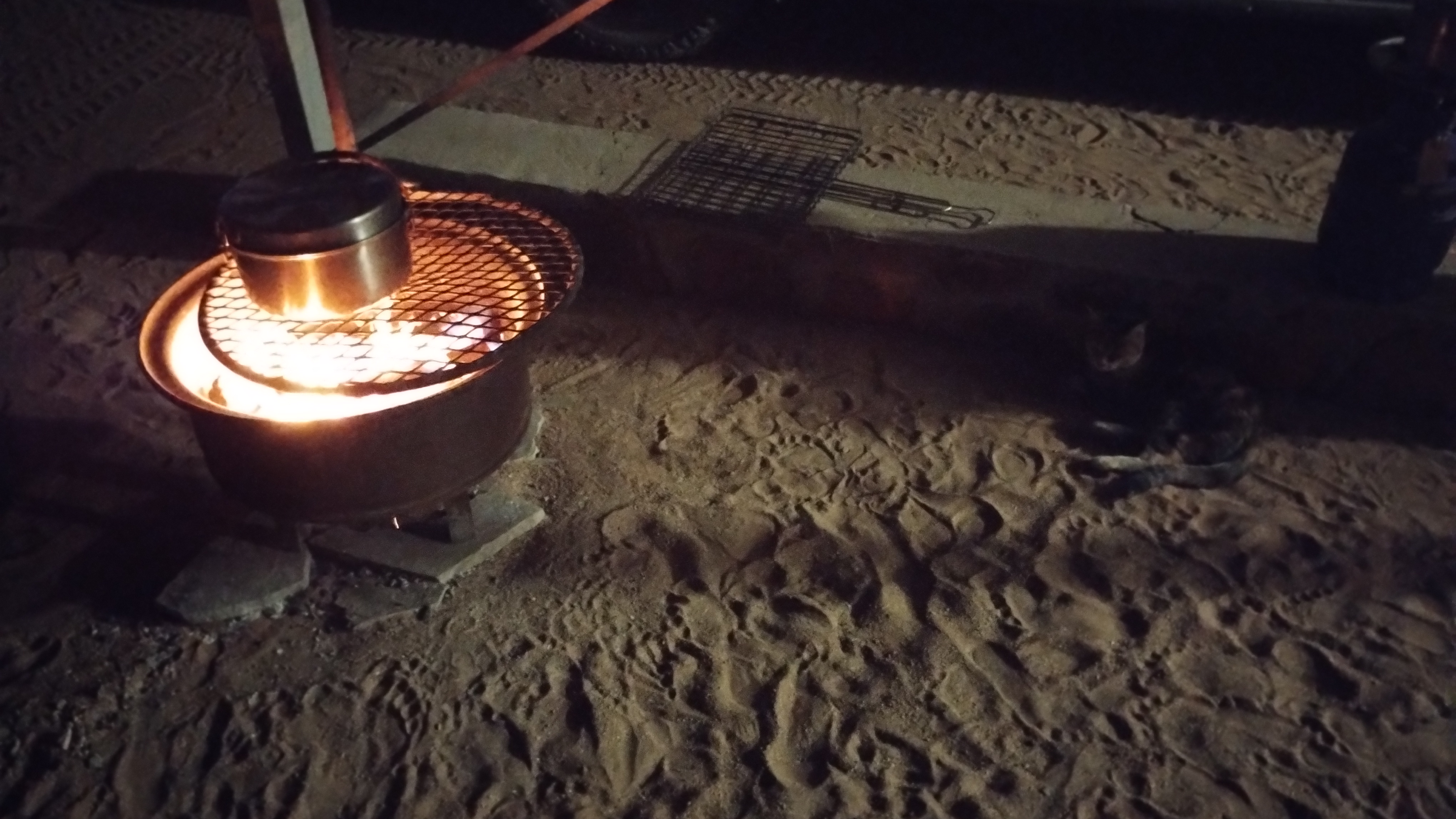
Before going to bed, we had to lock everything up in the campsite, because apparently, there were jackals known to steal food—and especially shoes.
Day 3: Sossusvlei, Inside the Namib Desert
The plan for the day was to visit the Namibian desert, famous for its towering dunes. As such, we left the campsite as early as possible—the later we went, the hotter it would get. We woke up at 6 a.m., followed the C19 to Sesriem, and were at the dunes by 9 a.m.
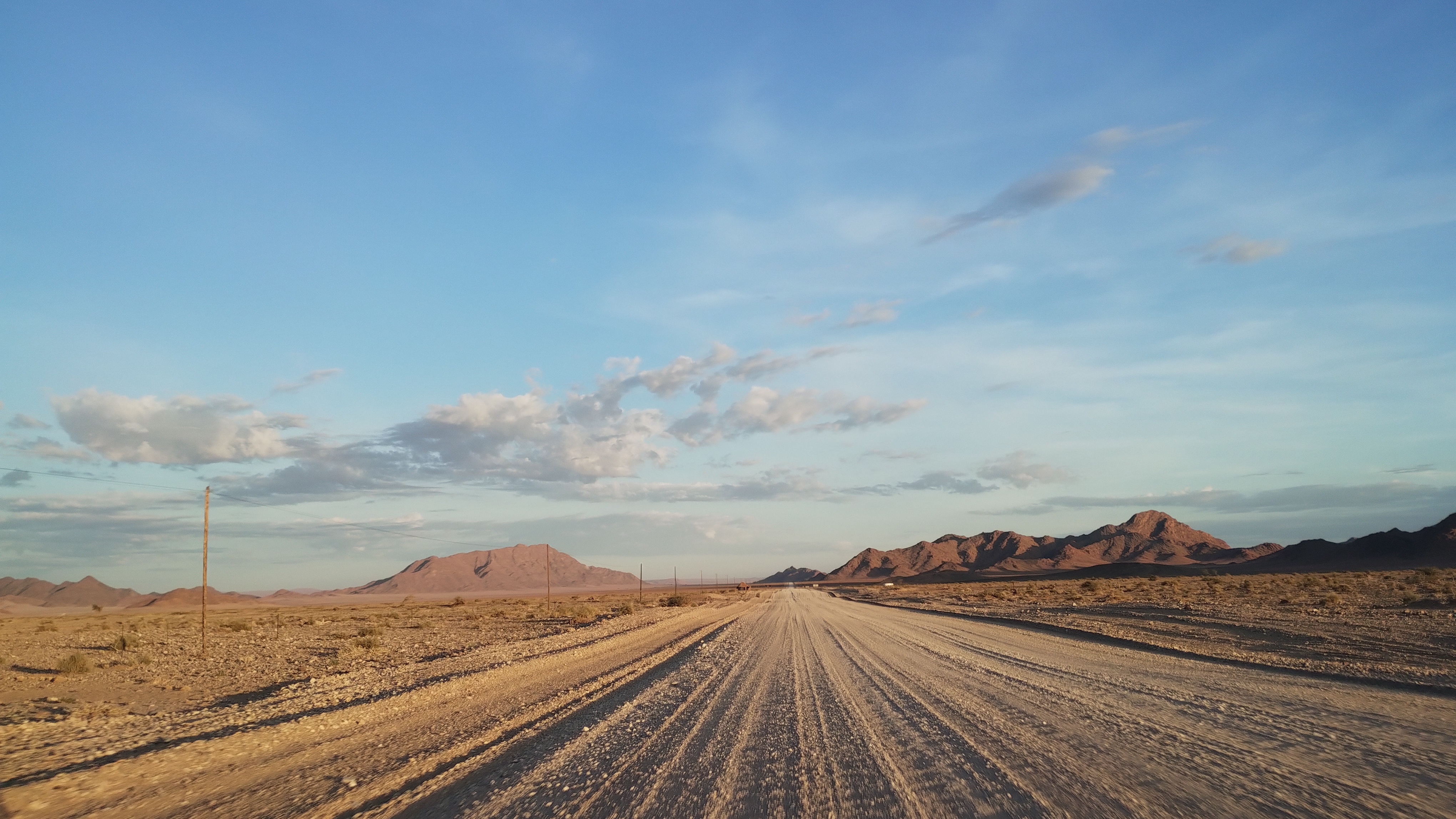
The car ride itself was relaxing but boring. We drove for over an hour on a road where the maximum speed limit was 40 km/h. The road was completely straight with no turns, and all you could see to the left or right was sand. The road was nearly empty, and when we did see a car, it was speeding at 40 km/h or more over the limit. This was the first time we realized that in Namibia, maximum speed limits seem more like a suggestion than a rule. However, it’s worth noting that Namibia ranks 9th in the world for the highest traffic-related deaths. So, I wouldn’t necessarily recommend following the locals’ lead.
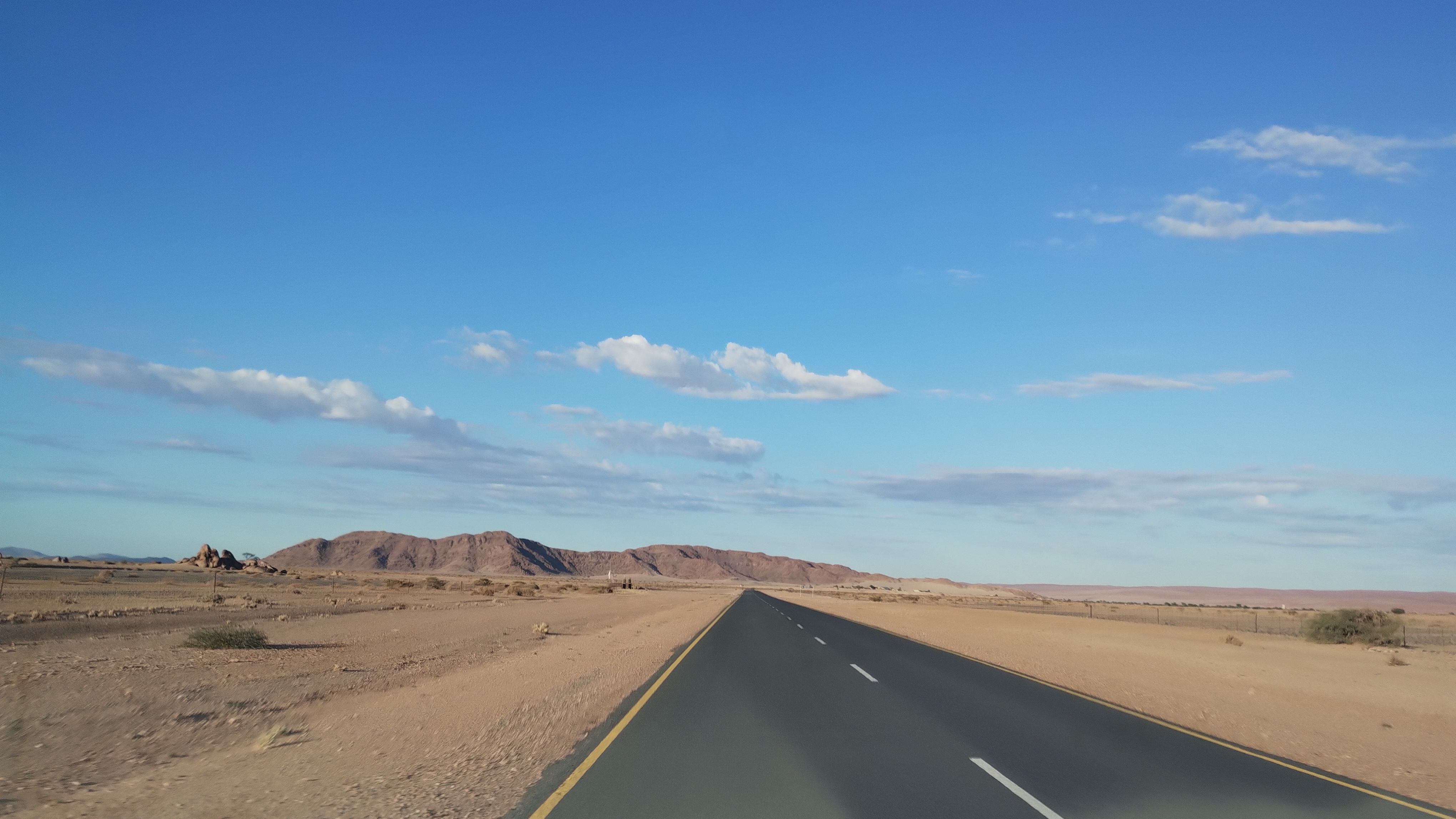
On this stretch of road, we also noticed that in Namibia, there are no signs indicating when the last speed limit sign is lifted. To this day, we’re unsure how it works. We would always check if we saw a speed limit sign on the opposite direction of traffic and assume that one applied to us.
Another reason the ride was boring was because of the car itself. It was automatic, so you only needed one foot for both pedals. Additionally, you could set a speed limit that the car would maintain, meaning you didn’t even need to use your foot to accelerate. With the straight road and no turns, we didn’t even need to steer. The highlight of the drive was when we saw our first exotic animals: springboks sitting beneath some trees and a jackal. We also had a brief moment driving on sand, which required us to lower the tire pressure to avoid getting stuck. One car behind us did get stuck, but they managed to get out.
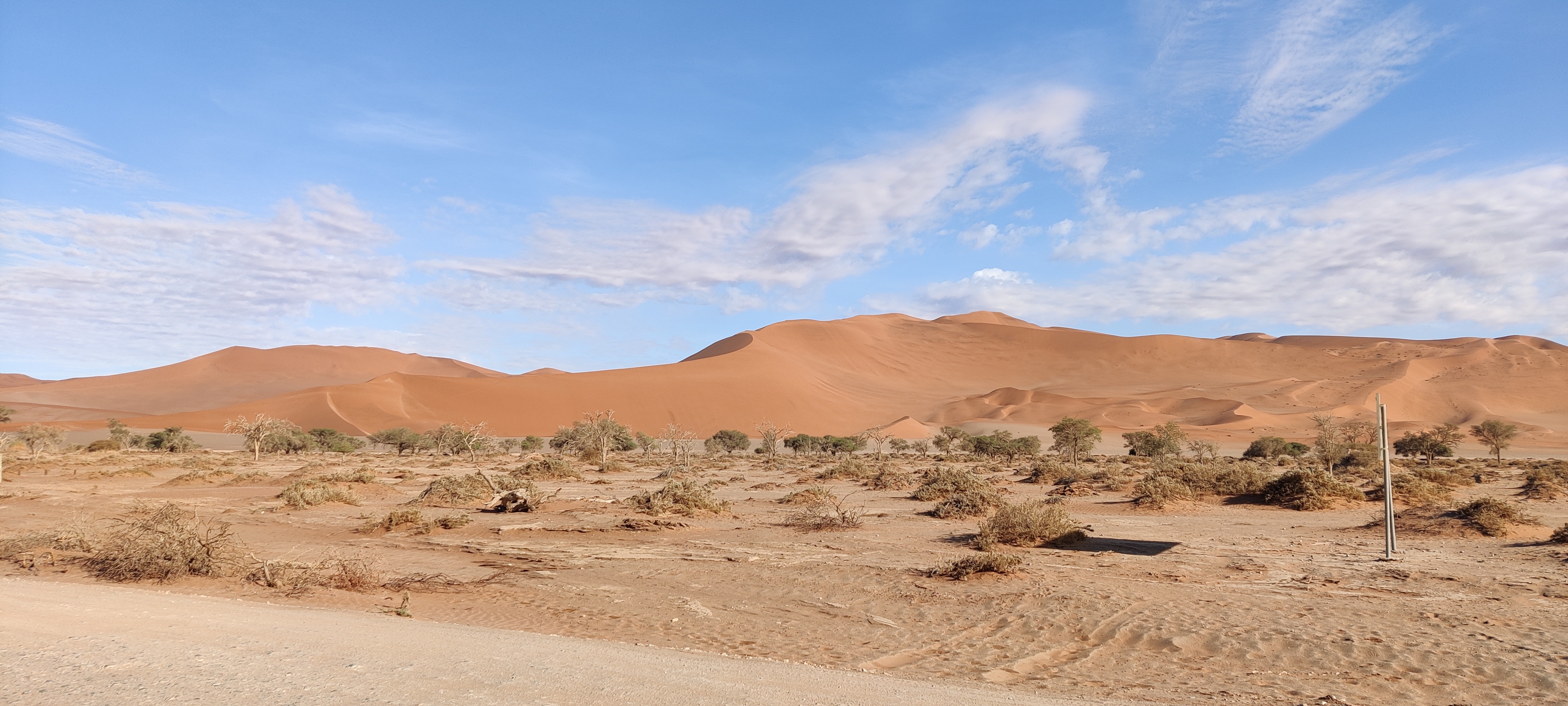
It’s incredible how diverse Namibia’s biomes are. On the first day in Windhoek, everything was green and lush with plants and trees. On the second day, we drove through a more stony landscape with less greenery but many mountains. Now, in the Namib Desert, there was neither much stone nor green, only sand. Sure, other countries like the U.S. have similar biome diversity, but in Namibia, all these biomes are just a day’s drive apart from each other.
When we arrived at Sossusvlei, the temperature was already above 30°C, and there were no clouds to shield the sun. With no shadows to hide behind, I can only recommend using a lot of sunscreen, bringing plenty of water (1 liter per person won’t be enough), wearing a hat, and having sunglasses. The plan for the morning was to climb Big Daddy, the tallest sand dune in the world, standing at 325 meters, visit Deadvlei, and then visit Big Mama for lunch.
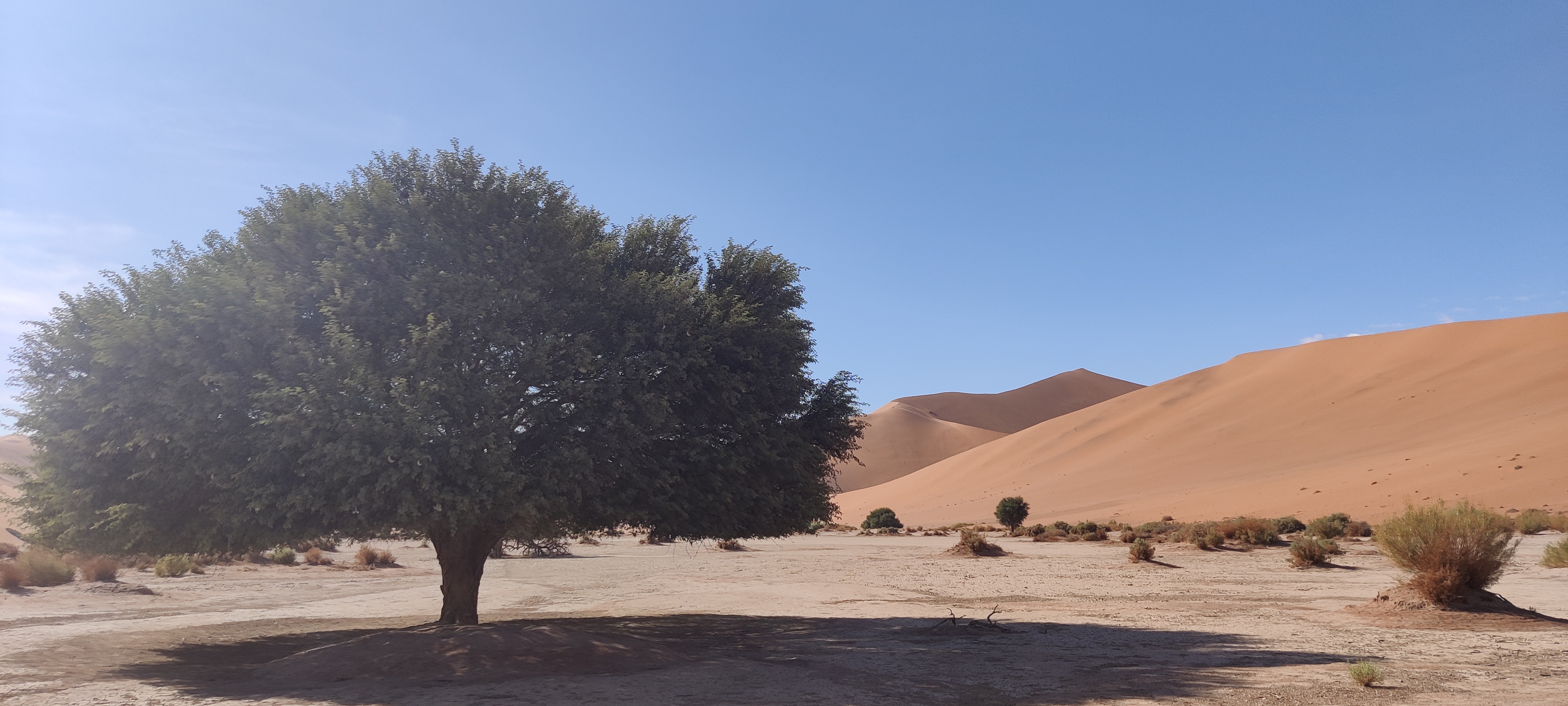
Climbing Big Daddy can take an hour or two, depending on how fast you are. Importantly, you can’t go straight up because you’d sink in the sand. Instead, you need to follow the ridge of the dune. The total length of walking isn’t that long, but each step sinks you into the sand, and you have to constantly try to walk on paths where others have already walked.
Reaching the top, the view is phenomenal. The way down is much quicker—if you’re daring enough to run straight down, it only takes about 5 minutes. Running down takes you straight into Deadvlei, a white clay pan famous for its dead trees, which are nearly 700 years old and have not decomposed due to the dry climate.
Walking through Deadvlei and back to the parking area can take another hour. When I finally arrived, I was exhausted. I hadn’t brought enough water, so I was incredibly thirsty. My clothes were full of sand, and the sun was relentlessly beating down on us.
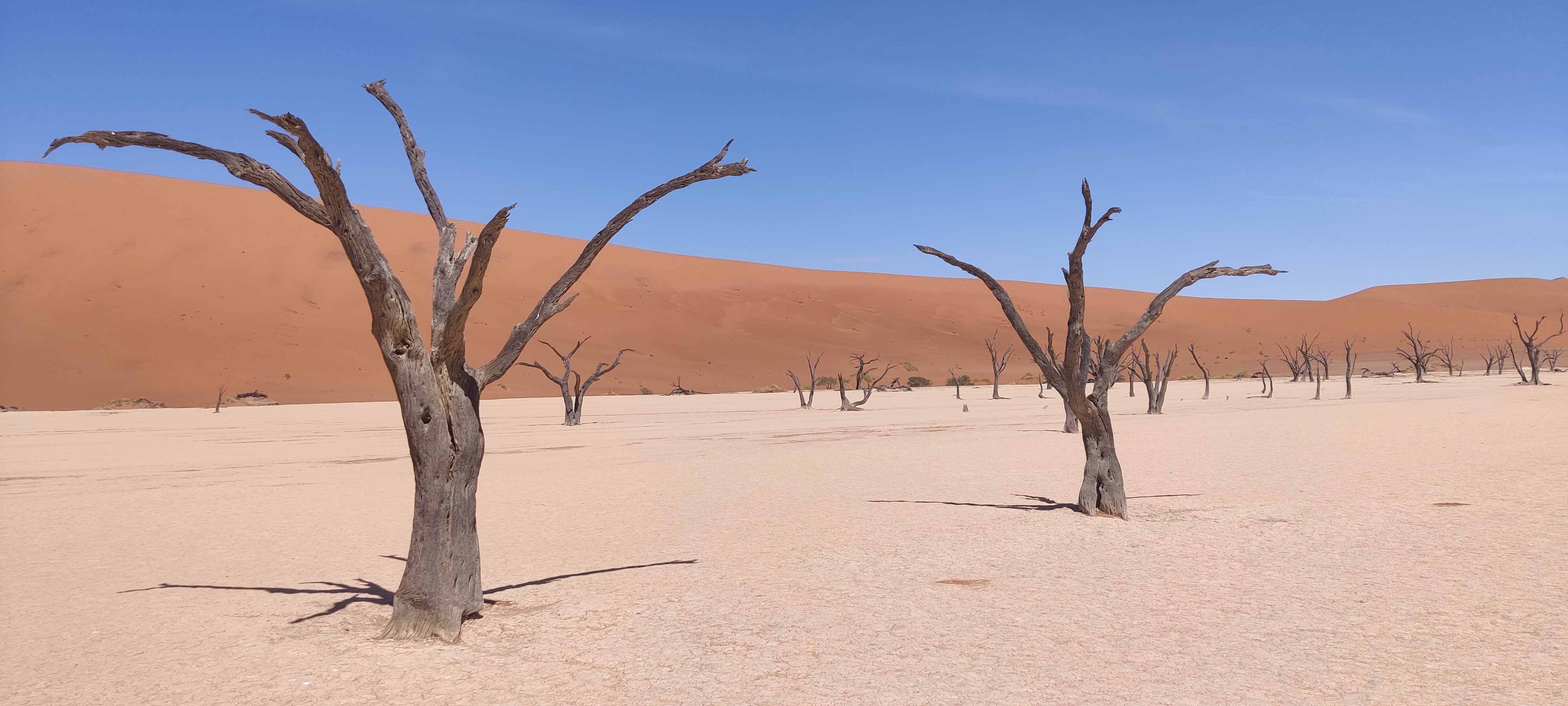
We decided against climbing Big Mama or any of the other smaller dunes and opted instead to eat a small lunch. It consisted of untoasted toast with fresh cream and cheese slices that tasted like nothing. It was one of the worst lunches I’ve had! Afterward, we headed back, but not before making a detour to the Sesriem Canyon. We could climb down and walk through it a bit, but since it had rained a few days prior, there was water at the bottom, so we couldn’t walk through the entire canyon.
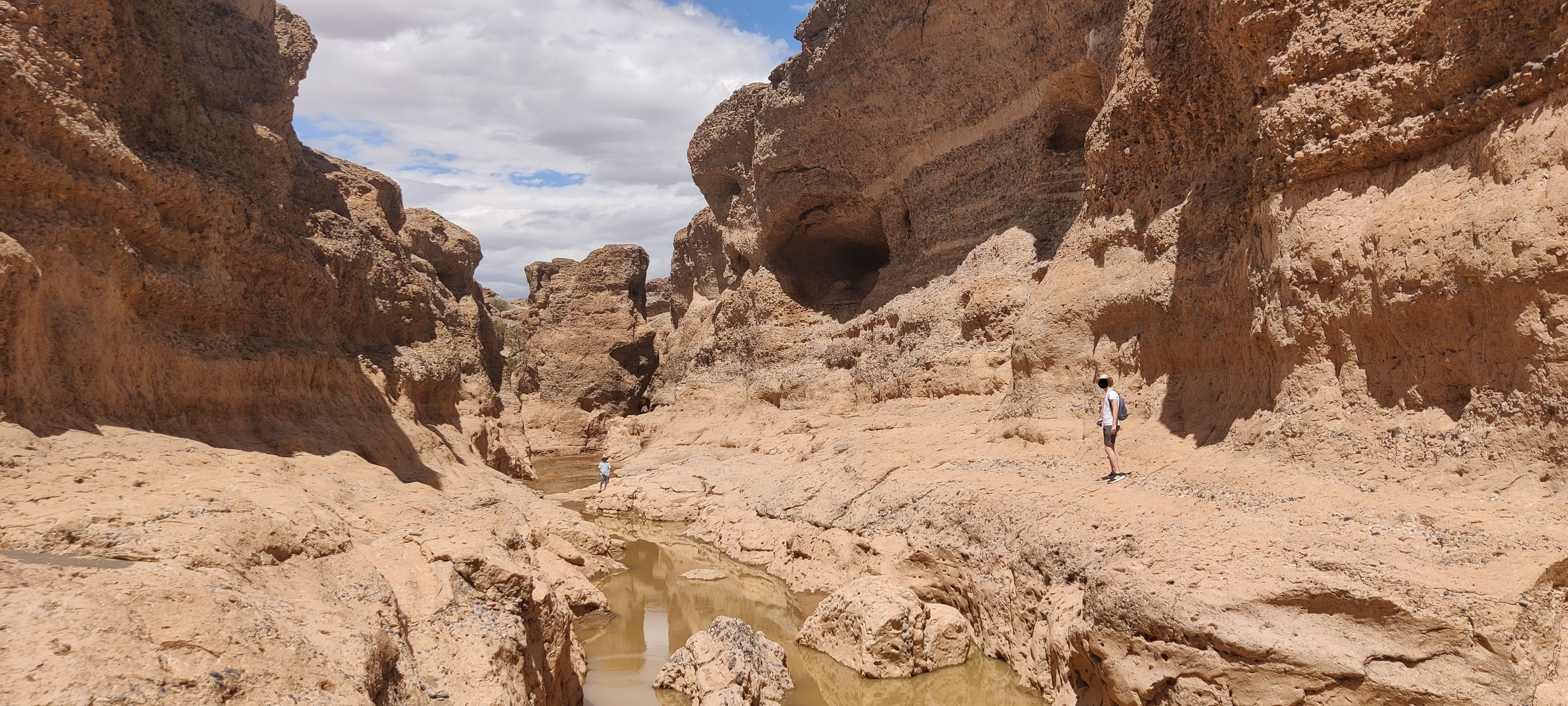
When we returned to our campsite from the day before, we relaxed in the pool, grilled some kudu meat with chakalaka, looked at the stars, and went to sleep.
Day 4: Driving and Swakopmund
This was mostly a driving day. We took the C14, stopped briefly in Solitaire for another slice of apple pie, and then continued all the way up to Walvis Bay.
On our way, we saw various animals such as gnus, oryx, and a Cape fox. We passed through two mountain passes again, though the views weren’t as spectacular as the first mountain pass we drove through on Day 2. The remaining route was the most monotonous drive so far—tens of kilometers of nothing but a flat landscape scattered with small stones. Every hill became exciting because we thought maybe something new would be behind it, but it never was. We dubbed this terrain the “void.”
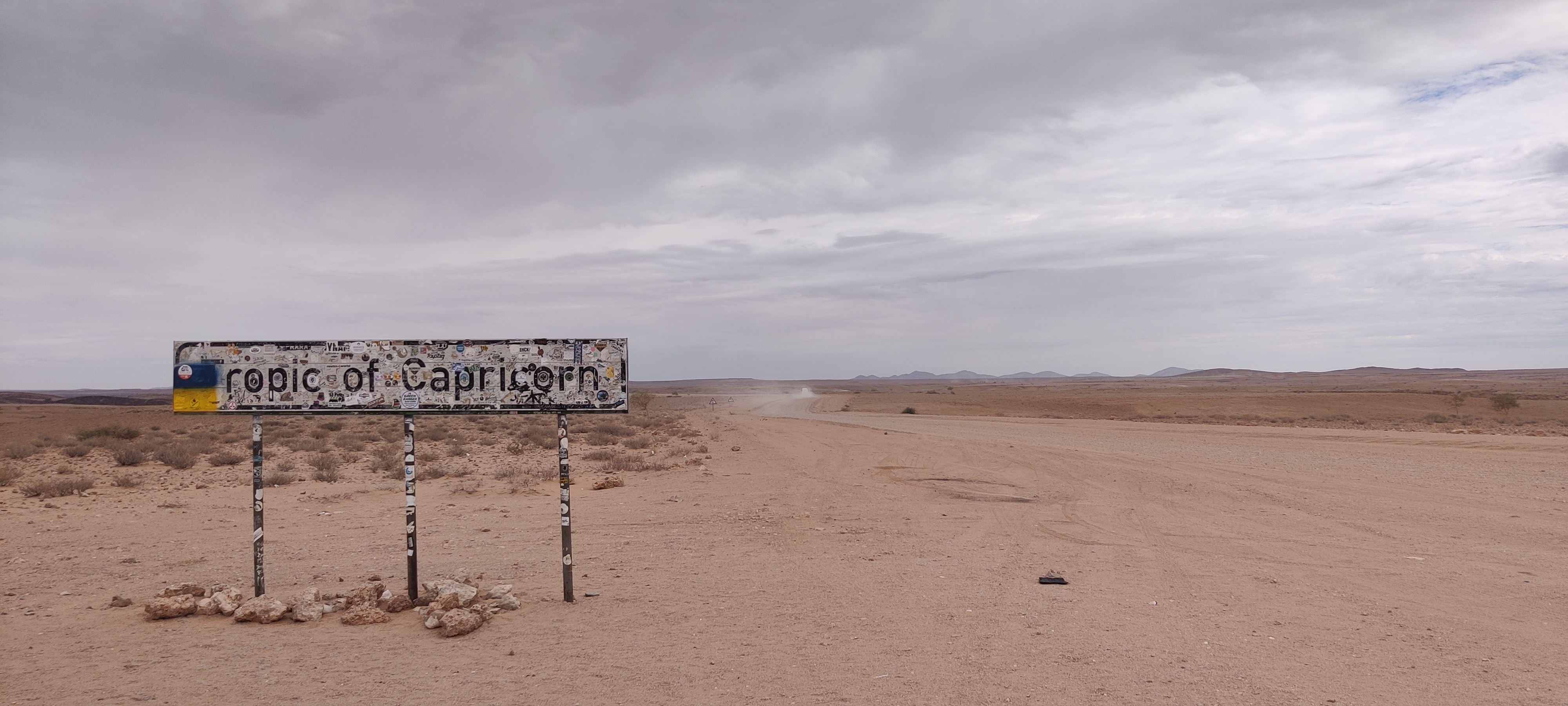
It was interesting to note that most of the land was privately owned, and nearly everything was fenced in. If it wasn’t, the owner marked their territory by piling up stones from the environment. I really wondered what people did with that barren, stony land, especially since it’s at least a two-hour drive from any other settlement.
In the afternoon, we arrived at Swakopmund, a coastal city near the Atlantic. It had the vibe of a small city along the Baltic Sea, with clear signs of German colonial influence, from the buildings to the fact that you could hear German being spoken wherever you walked.
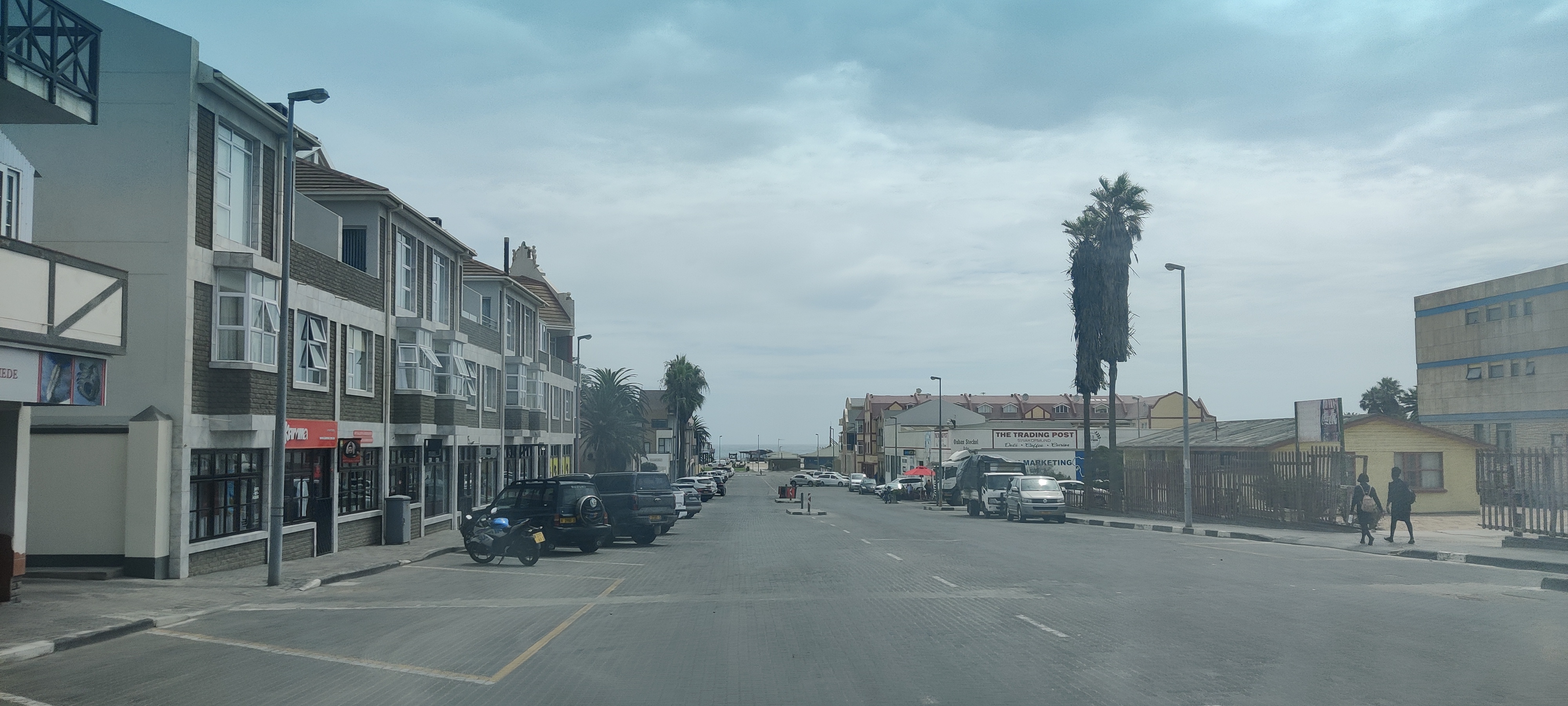
What struck me was that just a day before, we were in the desert, and now we were at the Atlantic. We checked for places to swim, but bathing was forbidden due to the strong currents. The first thing we did was walk along the coastline and pier, just soaking in the atmosphere.
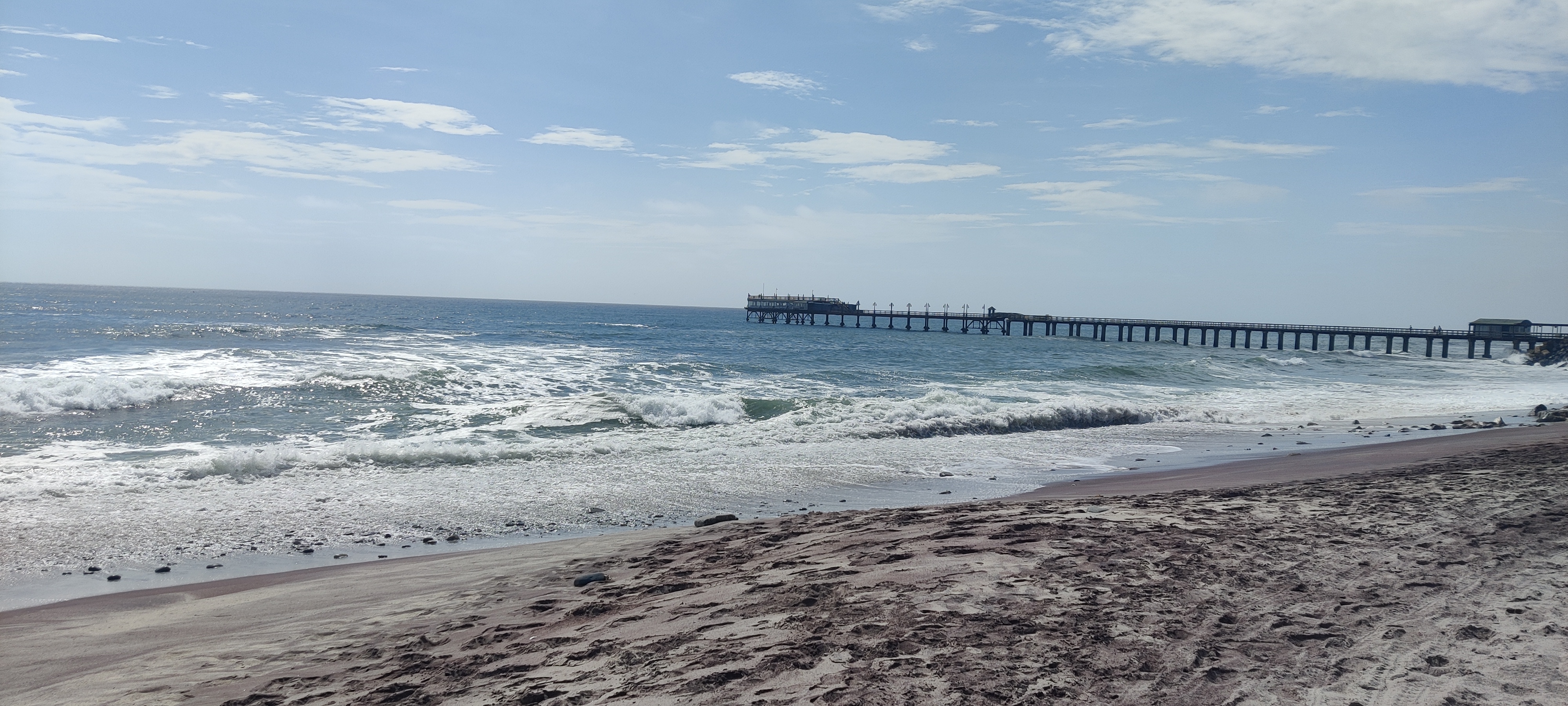
As I mentioned earlier, just before flying to Namibia, I had an optimization theory exam. When I checked the status of the exam, I found that I had failed it—for the second time. This meant I would have to take an oral re-examination, or I would be kicked out of university. Furthermore, I saw that the deadline to register for the insight (where you can check that the examiner didn’t miss anything or make a mistake) had already passed, and the professor had threatened that if I didn’t respond within the next few days, I would be expelled. So, I hastily wrote an email explaining my situation—being on holiday and having missed the email. Even though I knew it was now out of my hands and, as the Stoics say, “if it concerns anything beyond our power, be prepared to say that it is nothing to you,” it still cast a shadow over the rest of the day.
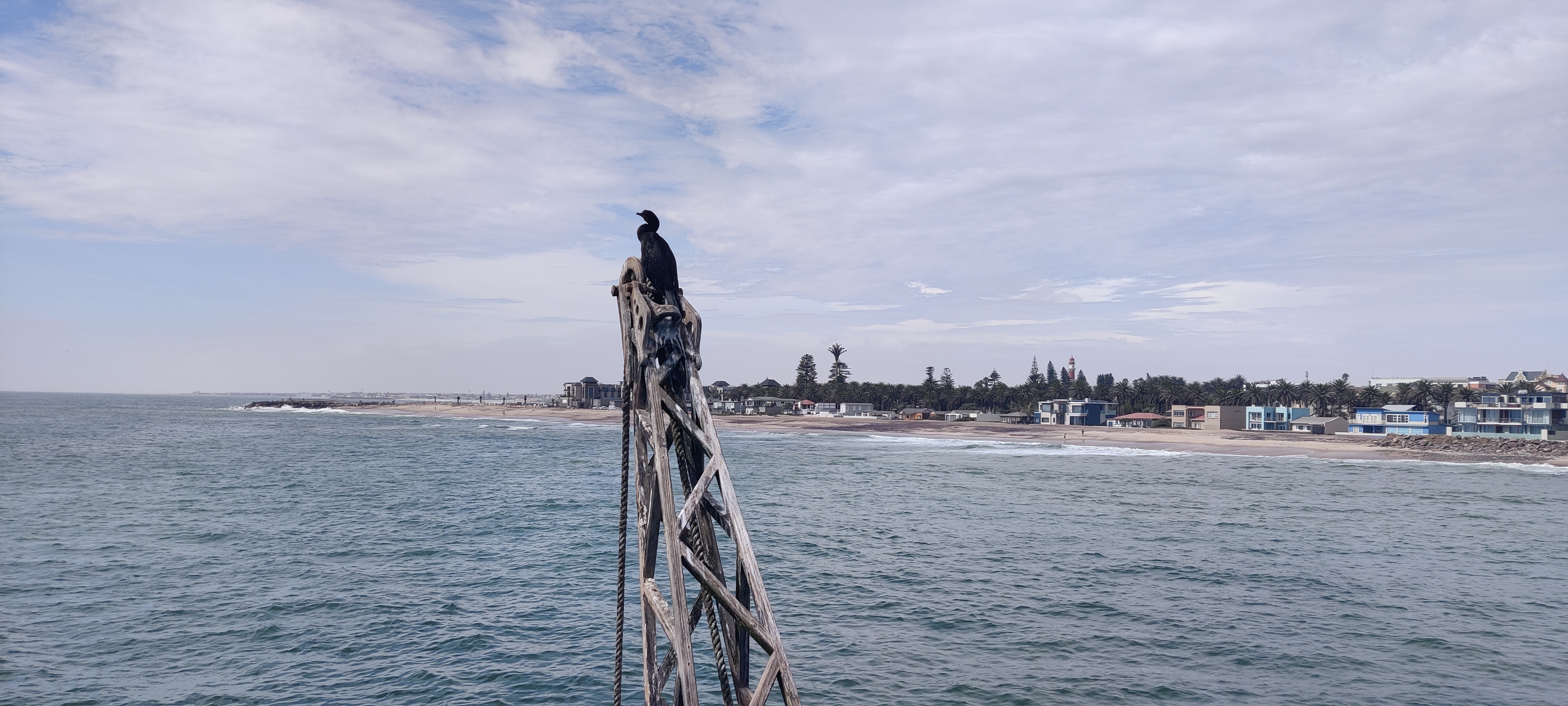
After our walk on the pier, we resupplied at the local supermarket since most of our food and water had run out. Finally, we could grab a snack, which we did at Kücki’s Pub. The food there was delicious. I got Beef Trinchado, a South African Portuguese dish, though the portion was a bit small. They served good beer, but the food leaned more toward German-style dishes than traditional Namibian ones.
In the evening, we watched some local TV in the hotel room. “Local” might be a stretch—there was one South African channel, which had a bizarre dwarf scene. Two dwarfs were on a romantic date, and the local barkeep kept harassing them and making jokes about their height. There was also a sports channel (which, surprisingly, was the most normal one, showing regular football), an Indian channel that was very over-the-top in traditional Bollywood style, an educational channel that looked like Khan Academy lectures, and a Western channel showing Hawaii Five-O. I had remembered Hawaii Five-O as being quite good, but watching it again, it seemed more like a bad soap opera.
Day 5: Cape Cross and Seals
Today’s plan was to head out to Cape Cross, which is famous for its seal colony, the largest in the world, and do some kayaking around them to get a closer look.
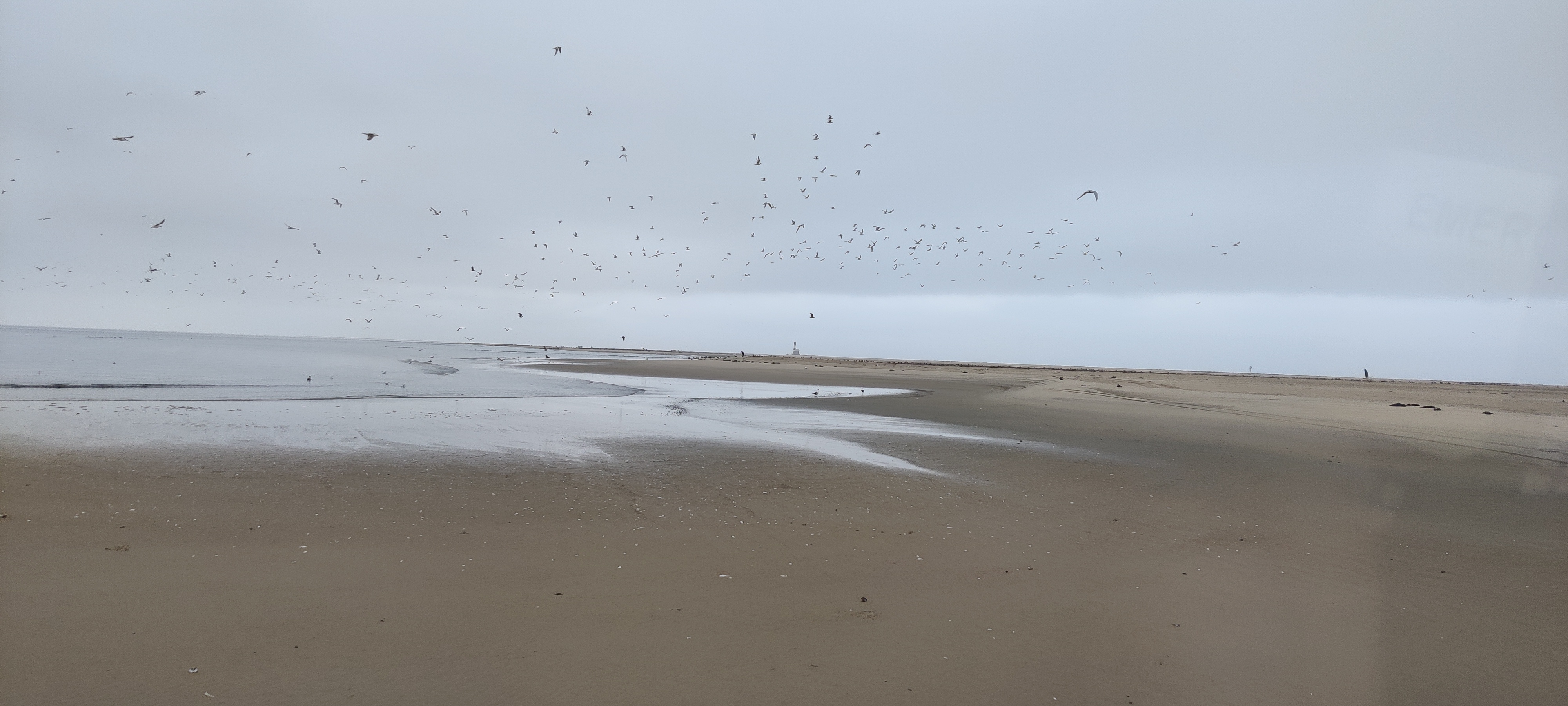
The kayaking excursion was based in Walvis Bay, and a guide drove us towards Cape Cross. The colony there consists of nearly 100,000 seals, all grouped together in large clusters, sometimes as many as 2,000 per group, scattered around the cape. Surrounding them, jackals roamed the area. Interestingly, the jackals don’t hunt the seals; instead, they wait for a seal to die, which happens quite often, as nearly 40% of baby seals don’t survive. You could see dead seals lying around everywhere, their carcasses being scavenged by the jackals. What’s fascinating is that there’s no fresh water available to the jackals, so after feeding, they need to walk for almost two days before they can find fresh water again and then return.
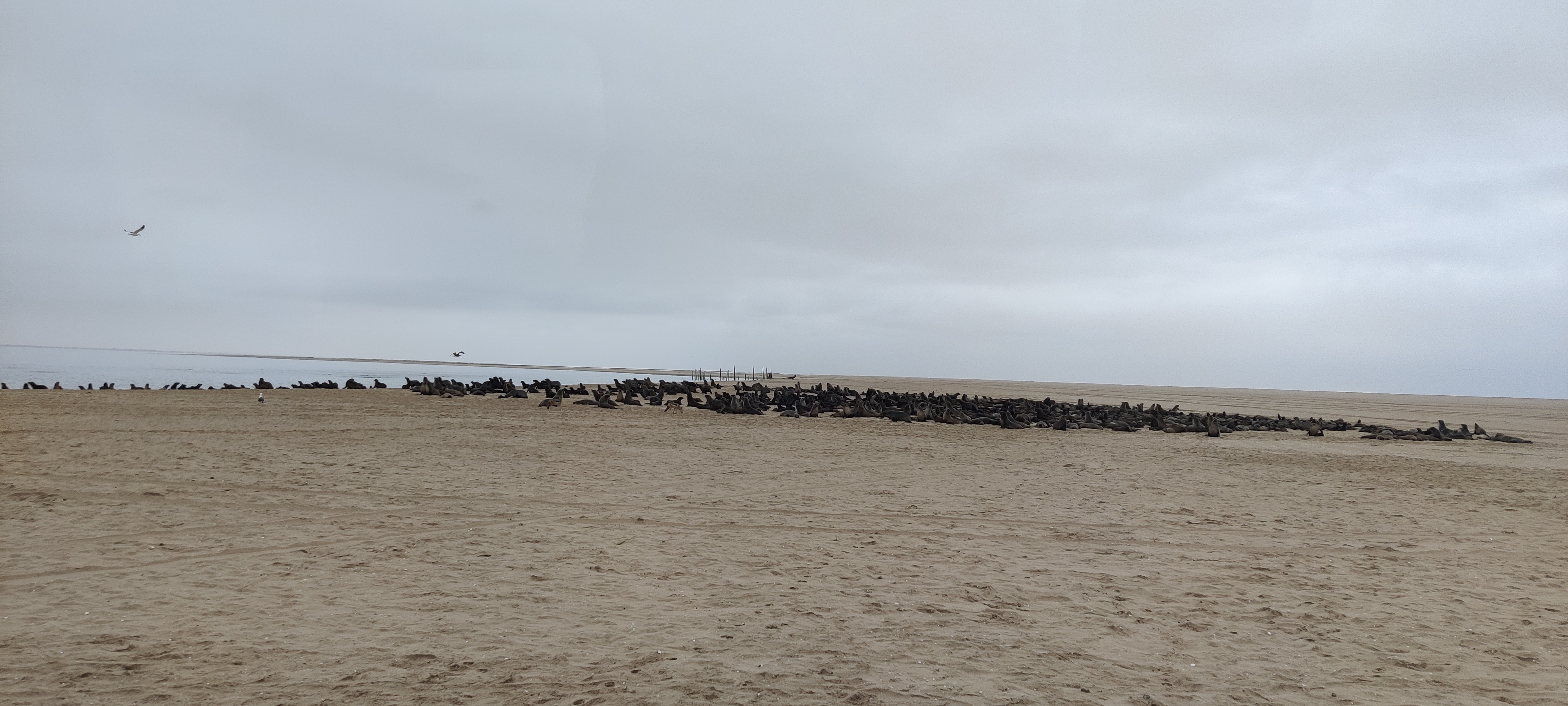
We also saw some pelicans and flamingos, which can be classified as greater and lesser flamingos. These flamingos travel up to Botswana when it rains, sending out scouts to check for rainfall. If the scouts don’t return, the rest of the flock knows it has rained, and they head off to Botswana.
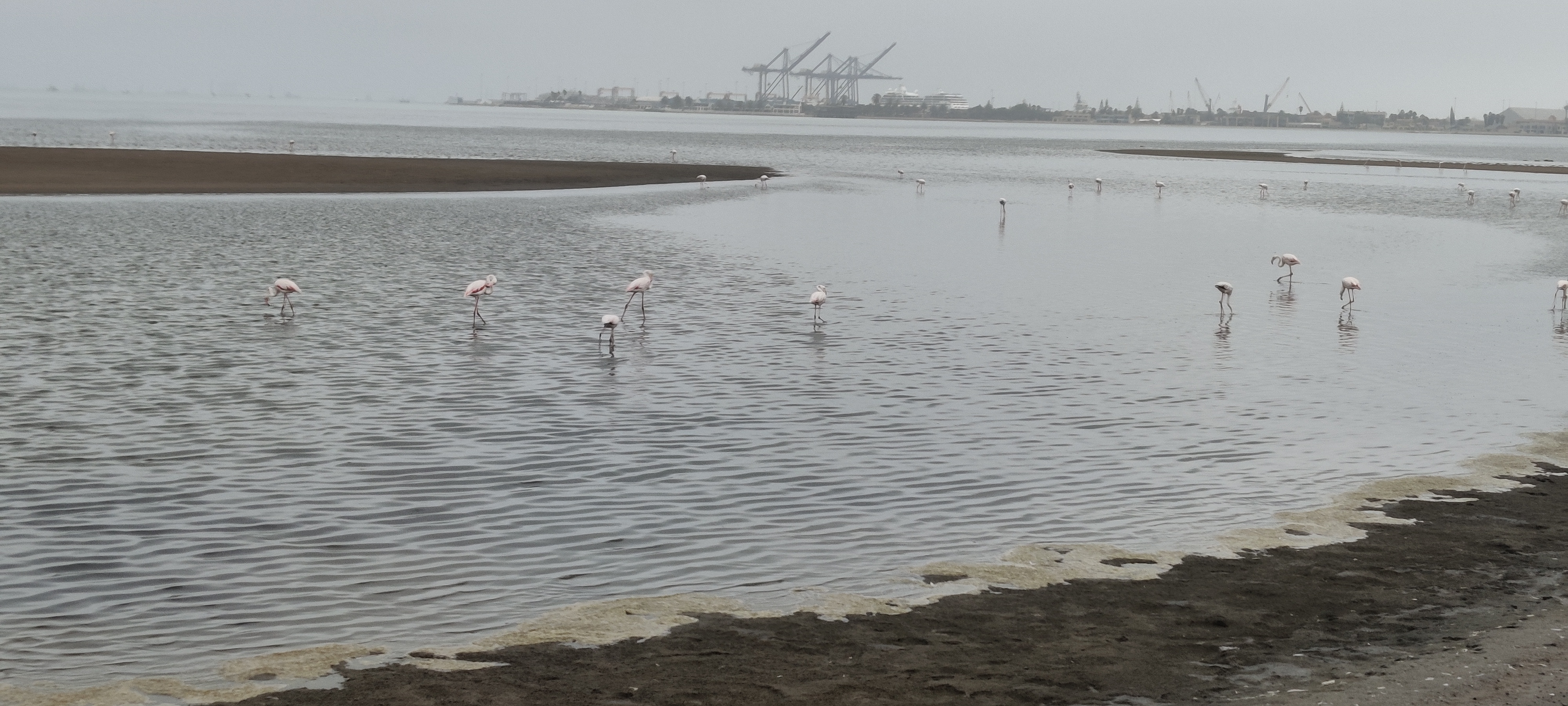
The ocean around the area was filled with tanker ships, as Walvis Bay is a harbor. Around 300 years ago, it was used as a jumping-off point for whale hunting, and for a long time, there were no whales in the area. However, they have recently started to return.
After exploring the area, we hopped into our kayaks and paddled around the seal colony, getting as close as a few meters to the seals. A bit further out, we spotted a dolphin. Interestingly, dolphins are the primary food of orcas, who love to hunt them but don’t bother with seals.
Here’s a rapid round of seal facts:
- Female seals are pregnant for most of their lives. For four months, the fetus doesn’t grow, then for eight months, it develops, after which the seal gives birth, gets pregnant again, and the cycle continues.
- At 12 years old, male seals become dominant and claim a harem of females.
- Seals have no natural predators, either on land or in the water in Namibia.
- Lions have recently started preying on seals, but researchers are trying to keep them away because seals contain an enzyme that lions can’t digest, causing them to die.
- Seals sleep with their noses up in the air to smell better. If one of them detects danger and runs away, all the others follow.
The guide was friendly and gave us a good tip: if we’re driving to Etosha on gravel roads (which offer a more cinematic view than the asphalt roads), we should be careful, as the rain from the previous days might have made some roads undrivable due to rivers. We should check with locals for safe routes, a tip we forgot, which caused some issues later on in the trip.
I’ve mentioned before how the traffic laws in Namibia seem to be more like recommendations than strict rules, and this was perfectly illustrated on our way back from Walvis Bay to Swakopmund, where a police car overtook us, speeding by 20 km/h.
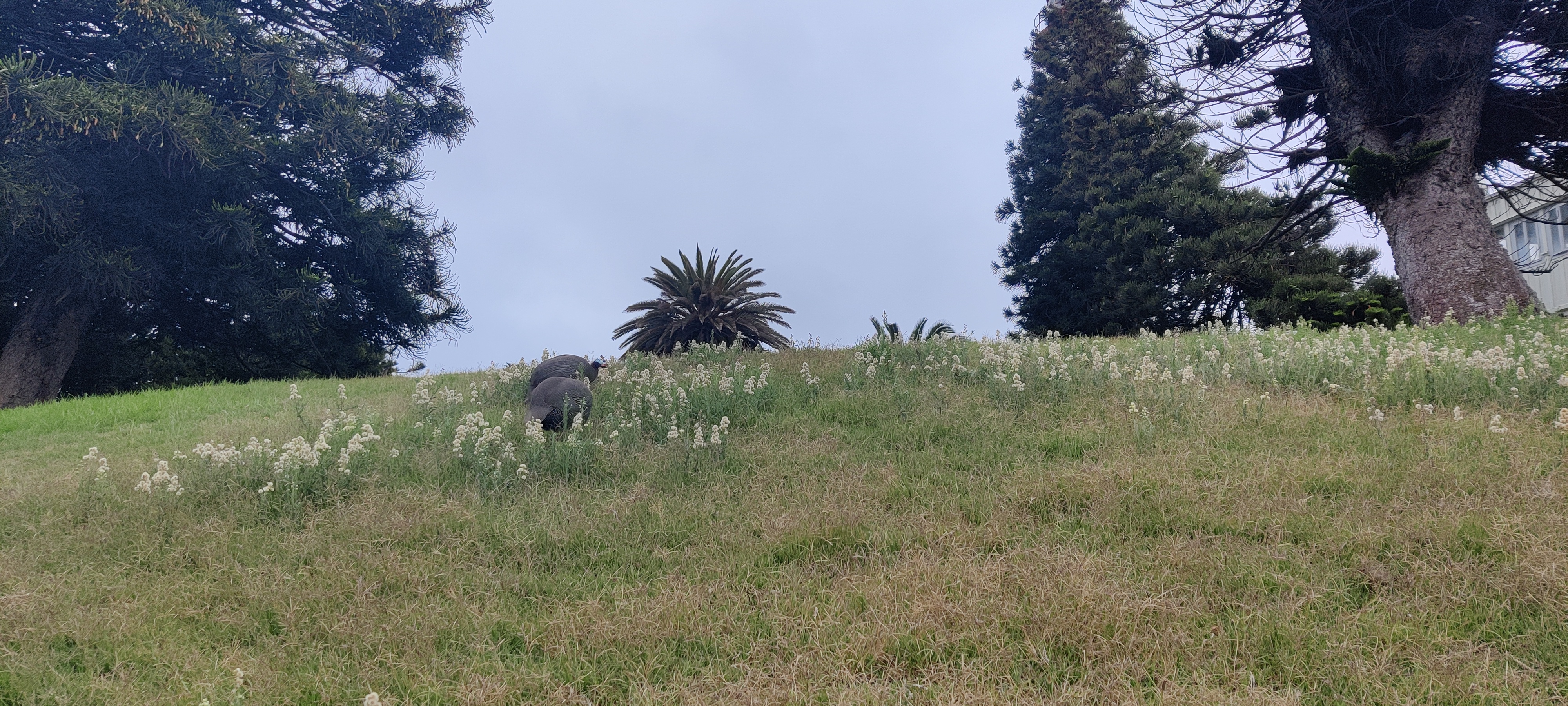
In the evening, we took a walk around the old parts of Swakopmund, visiting places like the presidential summer house. Just in front of it, we saw animals that looked like a mix between chickens and peacocks crossing the streets. We also visited the old railroad station. For dinner, I had some Namibian pizza, which replaces the boring salami with a variety of different game meats—highly recommended!
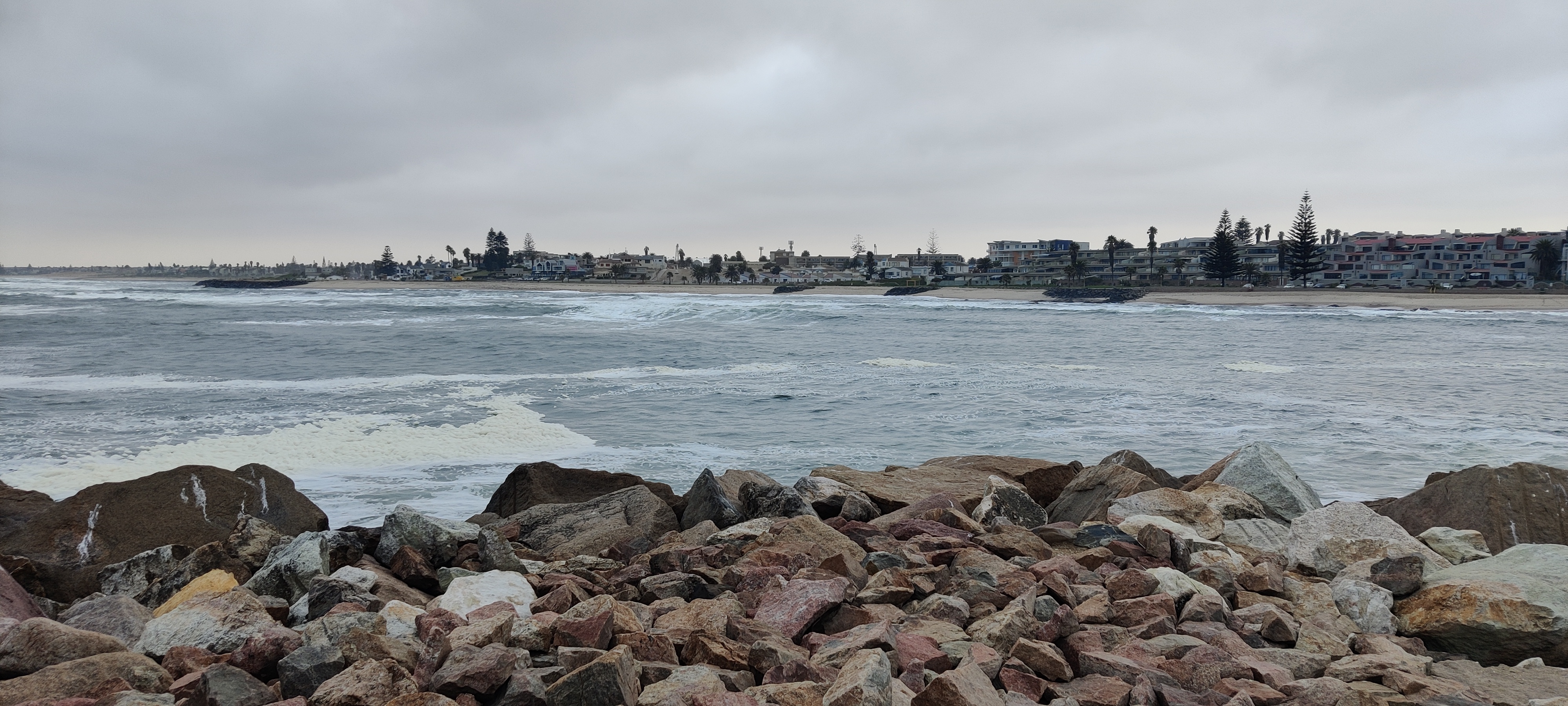
Day 6: Skeleton Coast and Spitzkoppe
Remember the issue with my optimization theory exam? I finally got a response email from the professor, who graciously allowed me to attend the insight session for the exam, even though I had missed the deadline. Things were looking up—great news to start the day with.
It was time to continue our journey, so we packed up and said goodbye to Swakopmund. We drove along the C34 from Swakopmund to Henties Bay. This route was a pleasure to drive as it runs along the Skeleton Coast, a stretch of coastline famous for its harsh conditions. The area got its name because of the many shipwrecks that occurred due to frequent fog and the treacherous, sharp coastline. Ships would often crash, and if they survived and managed to make landfall, all they would find was endless desert with no access to food or water. Survival chances were slim. The coast is still littered with the remains of these wrecks, many of which have never been removed. We stopped at one wreck to take some photos, but as soon as we left the car, we were swarmed by a group of locals trying to sell us items, which made us leave quickly.

The day before, the kayaking guide had warned us about the gravel roads due to the rain, but we completely forgot his advice. While driving, we came across a closed gate, which is common in Namibia as protection against wild animals. From what we heard, when you encounter a gate like this, you should leave it as you found it—so we closed it after going through.
Soon after, a man came out of his house, walking toward us and shouting. We weren’t sure what he wanted, so we waited for him to approach. He introduced himself as a local and began telling us how poor he was and how hard he had worked as a miner. We weren’t sure what he was expecting from us, but we offered some coins, which he declined. Just then, another car drove through the gate, distracting him long enough for us to quickly drive away.
The road was muddy, but we kept going. As you might expect, we got stuck. We tried maneuvering the car, but it wouldn’t budge. We got out to assess the situation, and sure enough, the car was stuck in the mud. I used the shovel to dig around the tires, but we couldn’t get it free. Thankfully, another car that just had driven past us was occupied by tourists from South Africa. They had traction boards—these are boards that can be placed under tires to give them more grip. Further the local helped us dig, and once the car was free, the South African tourists used the boards to pull us out of the mud. Afterward, we thanked them, and as we re-inflated the tires, the local man—who had helped—started telling us his life story.
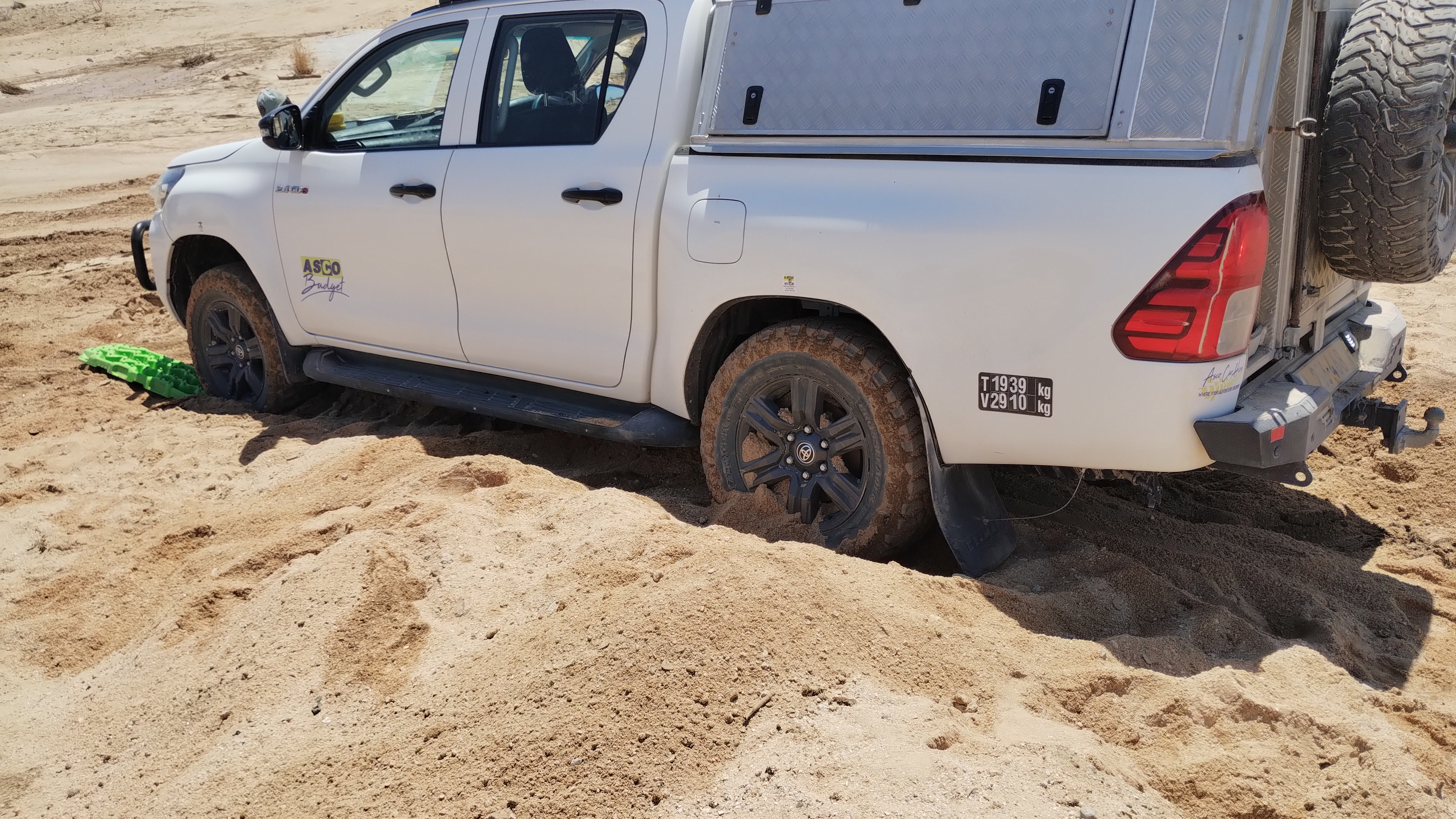
His name was Baki Johannes. His first name was his tribal name, and his second name was his Christian name. He went to school until he was 18, but then was forced by South Africa to fight as a soldier for the next nine years—likely during the Namibian War of Independence. After returning from the war, he went back to live with his mother in his home village. His great-great-grandparents were German and Polish, arriving in Namibia in 1864, and one of them married a person from the San people. He himself didn’t speak German, but his daughter was learning it at the Martin Luther School. As we left, he said that “the Father in Heaven has led us to him” and that in his eyes, we were all the same people.
After this encounter, we continued our drive to our destination for the day: Spitzkoppe. This mountain is famous for its challenging climbs due to its smooth surface, which made it only climbable in the 1950s. We looked for a camping spot, which we could choose freely as long as it was unoccupied. Some campsites are better than others, especially if they have some shade from trees. The best campsites also offer a good view of the mountain at sunset, when the light turns it a deep red. I’d recommend Campsite 11A or 11B, both of which offer easy access to a rock with a fantastic view.
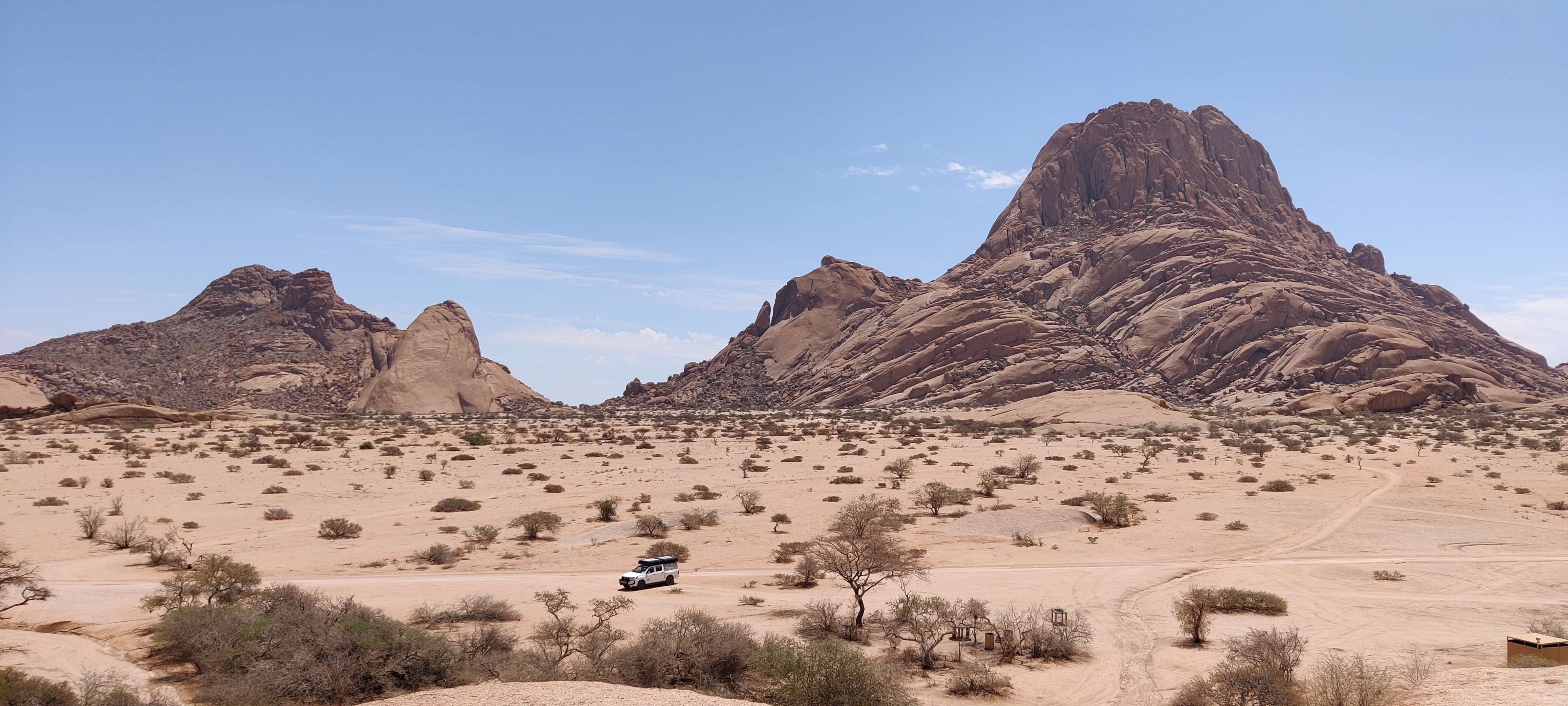
We drove around Spitzkoppe and visited the “Bridge” rock formation, where we met a friendly couple of German tourists. In exchange for a photo of them, they took one of us. We also visited the rock pool—a small pond surrounded by stones. But here’s the surprise: we found a turtle living in the pond! We asked a local about it, and he told us that the pool isn’t always there year-round. When it’s not, the turtle buries itself deep in the sand.

In addition to the mountain, the area is famous for its ancient Bushman paintings. These paintings are between 2,000 and 4,000 years old and were made by the Bushman, the native people of the region. There are two sites where you can view them. One is easily accessible by foot, and the other requires a 100-meter climb up a mountain. Once you’ve seen one, you’ve seen the other too, but the paintings on the mountaintop are more rewarding due to the better view. For both sites, you need a guide, who are usually hanging around and can be tipped afterward based on how much you feel their tour was worth.
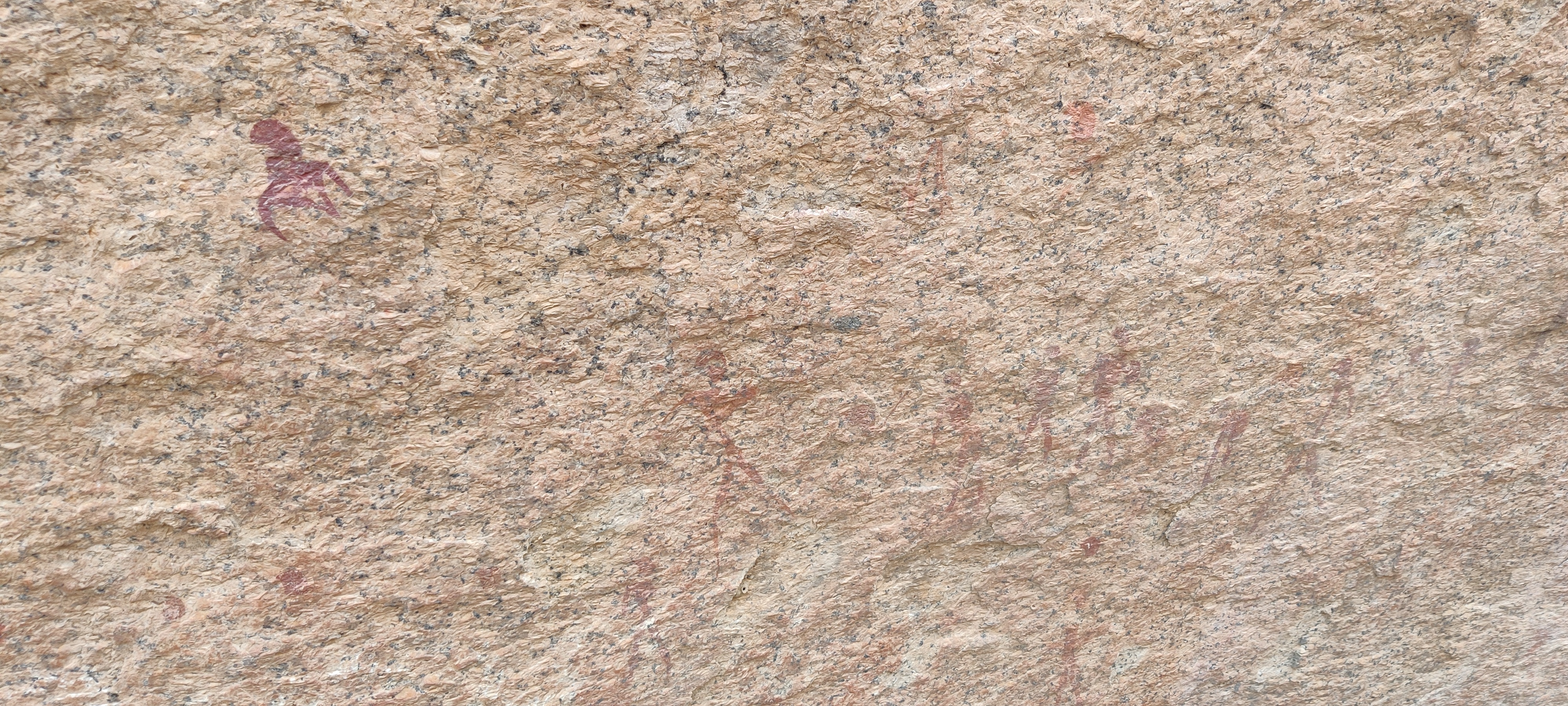
The paintings were made using animal blood mixed with powders to create color. They’ve been so well-preserved due to the dry climate and lack of moisture. The paintings depict various animals that the Bushman people encountered, and they were often used to communicate information about these animals to other groups. Interestingly, there’s a squid depicted in the paintings, even though we’re in the middle of the desert. This is because, long ago, the area was actually covered by sea. If a Bushman group grew too large (over 26 people), they would split into smaller groups because it was more efficient to gather food that way.
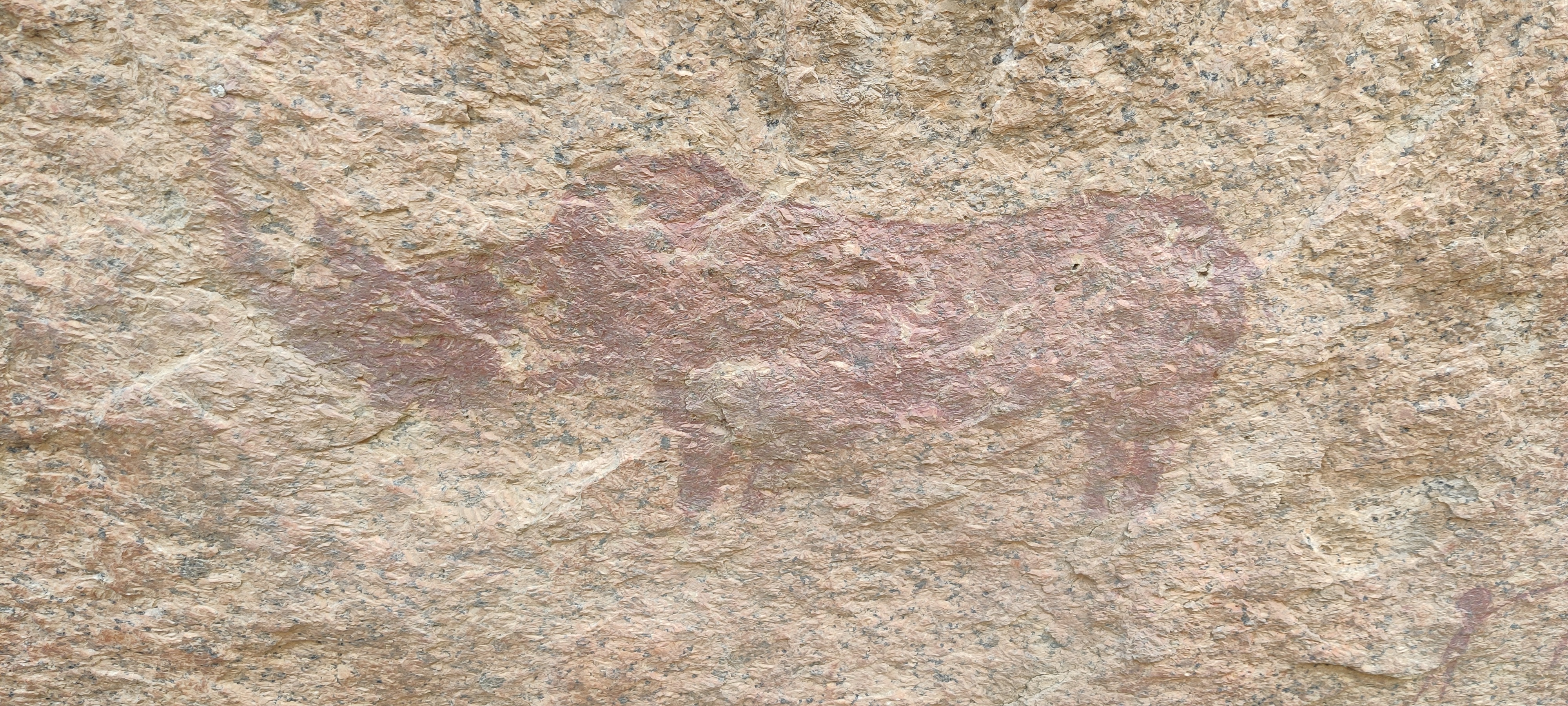
In the evening, we sat on the aforementioned rock by our campsite, drank some apple cider, and admired Spitzkoppe as the sun set, turning the mountain red. The rock was also home to a few Rock Hyraxes, which were very trusting. You could get as close as a meter to them, and they wouldn’t care.
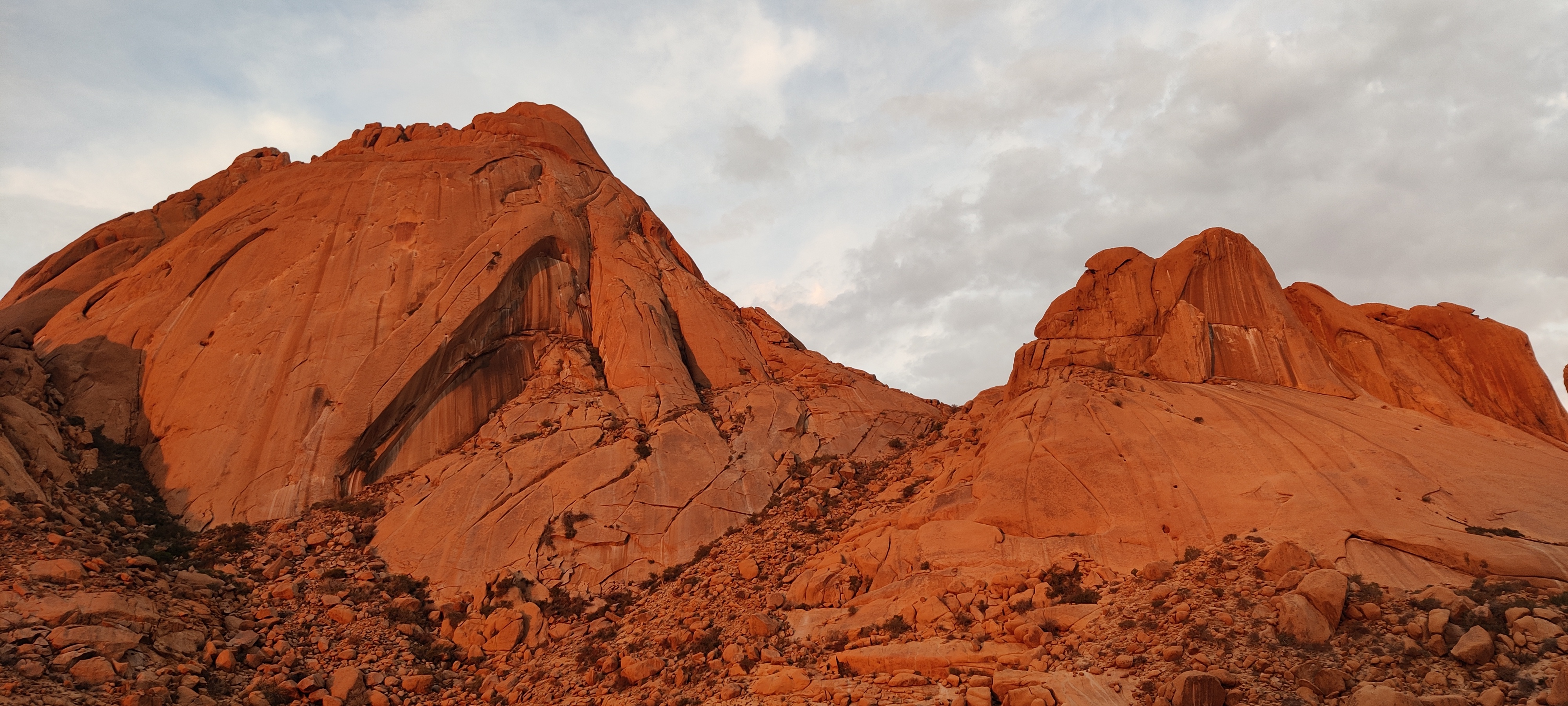
Day 7: Traffic Mayhem
Today was a driving day, and it was a crazy one at that. One of the main roads, the B1, was undergoing renovation. The goal was to add new lanes, but the old lanes were still accessible. Being a major highway, it was packed with cars. The speed limit was 60 km/h, and overtaking was prohibited. Despite this, we saw regular cars overtaking and speeding, which was especially dangerous because the road was narrow. If you veered too far to the left, you’d fall off a 30 cm cliff where the new lane was supposed to be. One wrong move, and you wouldn’t be able to get back up.
For example, we saw one truck trying to overtake another, speeding, and the overtaking maneuver itself took almost a minute. We also witnessed, separately, a police car, a city council member’s car (it was clearly marked with giant letters on the side), and a military truck overtaking and speeding. It was clear that overtaking was forbidden and the speed limit was posted everywhere—every 100 meters or so—but they still went ahead with it.
The situation was made even crazier by humans standing every kilometer or so on the side of the road, waving flags to indicate “danger.” I’m not sure how much it helped, given the way people were driving. The situation was made even worse by the road markings, which were all over the place. There were lines directing you toward the edge of the road, where the cliff was, lines that appeared and disappeared unpredictably, and lines leading into oncoming traffic.
The danger of this construction zone was not just theoretical; it was real. In the span of just 20 km, we witnessed the aftermath of at least two accidents. One truck veered too far to the left and ended up headfirst in the ground, while two cars collided on the side of the road. I think now you can understand why Namibia has such a high traffic-related death rate.
All of this chaos was summed up perfectly by a billboard we saw along the way, which read in big letters: “Please choose to obey the speed limit.”
One last thing about traffic that I couldn’t leave out: Not far from the construction zone, we saw a jeep in front of us that was overloaded with electrical scrap—things like fridges and air conditioners. When I say overloaded, I mean that the back was so packed with scrap that you couldn’t even see the driver’s seat, and everything was loosely held together with a few straps. Imagine if even one item fell off—fatalities behind the jeep would be certain. To make matters even crazier, the jeep was overtaken by a small truck. My friend, who was driving, asked if we should overtake too. I could only respond with, “When in Namibia, do like the Namibians do” (or, as they say, “When in Rome, do like the Romans do”).
As we drove, the landscape changed once again. It shifted from desert to rocky terrain, then back to the greenery we saw at the start of the trip in Windhoek. The landscape was also dotted with pointed dirt hills, some almost as tall as trees. My guess is that these were termite mounds.
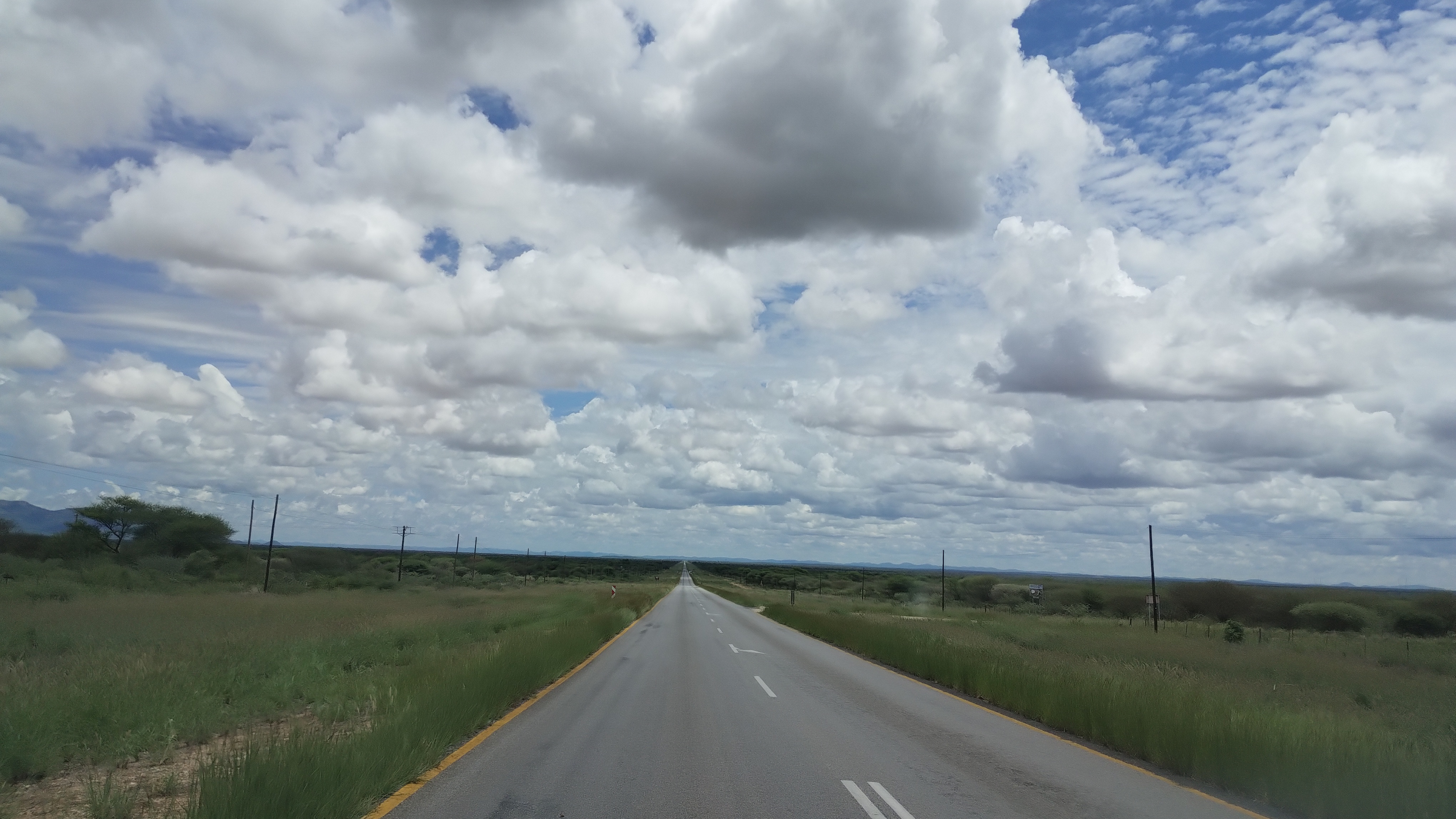
Day 8: Weirdness
Not much happened today. We drove from our campsite to visit Vingerklip Rock, which looks like a giant finger. The entry fee wasn’t much—only around 20 Namibian dollars.
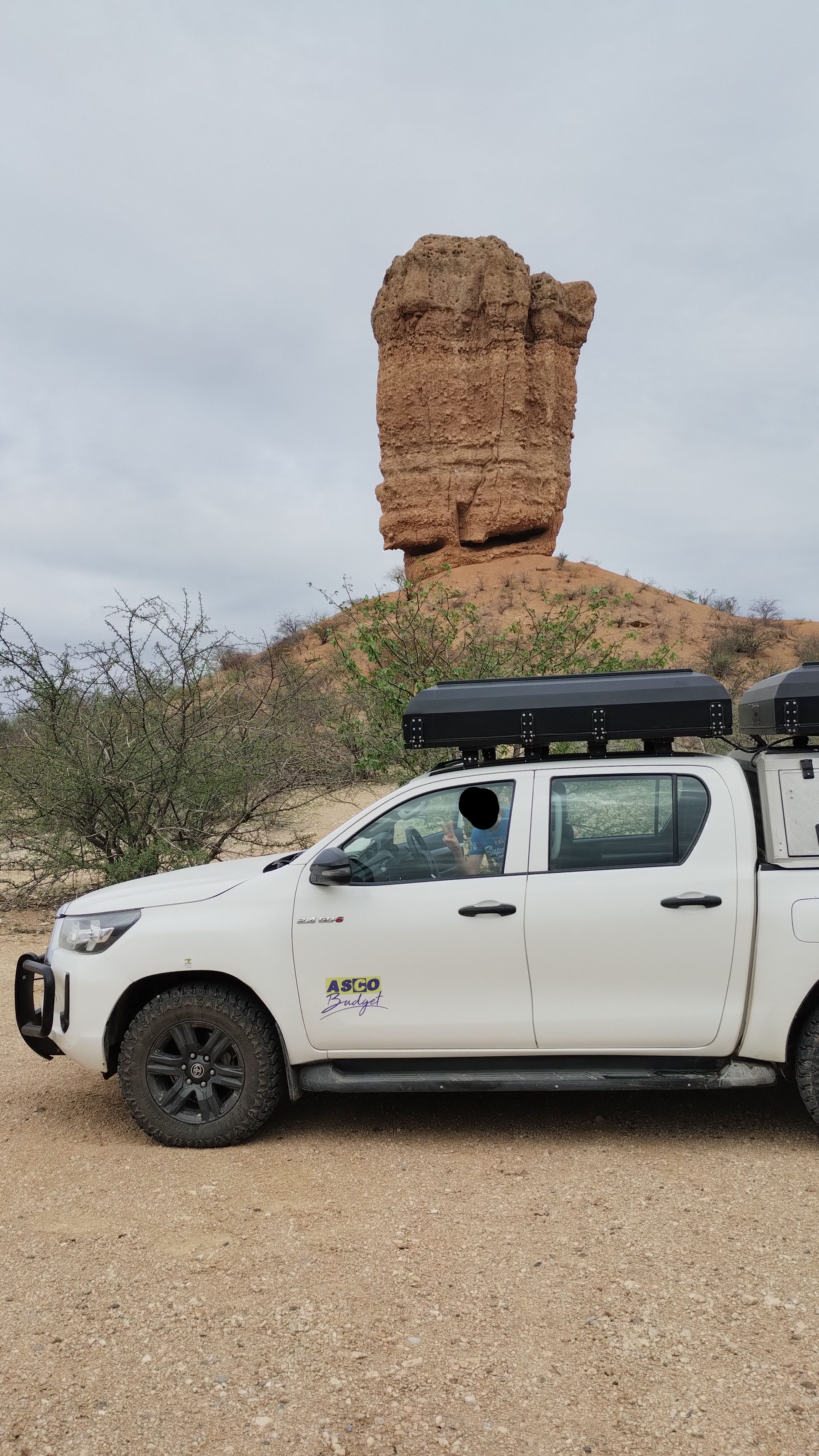
In the afternoon, I found myself in a reflective mood. Maybe it was because I had some time during the drive and finished reading the book Stoner. It made me think about what it means to live a fulfilling life, about the journey so far, about the mundane versus the divine, and about virtue. I ended up writing down my incoherent ramblings.
On a happier note, we spotted some Chacma baboons by the roadside. They looked so fluffy! And just like in Sossusvlei, the night sky was breathtaking. There were so many stars, all shining so brightly.
Day 9-11: Etosha
All the menageries in the world turned loose would not compare to the sight I saw that day.
~ G. McKiernan 1876, about Etosha
This was arguably the highlight of the trip, the Etosha National Park and also one of the main reasons people visit Namibia. It’s famous for the abundant wildlife, and geographically, the park is centered around a vast salt pan, with the rest of the park surrounding it.
Etosha operates under specific rules: you’re only allowed to exit the car at designated rest or camp sites, and you’re required to stay inside the car otherwise. Visitors typically drive around to various waterholes, where the chances of seeing animals are higher. Whenever we spotted something, we’d stop, take a photo, and continue on our way. It’s highly recommended to book campsites inside Etosha well in advance, especially in the high season, as they get quite popular.
On our first day, the plan was to explore everything to the left of Okaukuejo camp, then drive to Halali camp to sleep there. On the second day, we’d cover everything between Okaukuejo and Namutoni camp. But when we arrived at Okaukuejo, we were informed that Halali had water and power issues, and we couldn’t stay there. So, we decided to skip exploring anything further left from Okaukuejo and head straight to Namutoni to ensure everything was operational there.
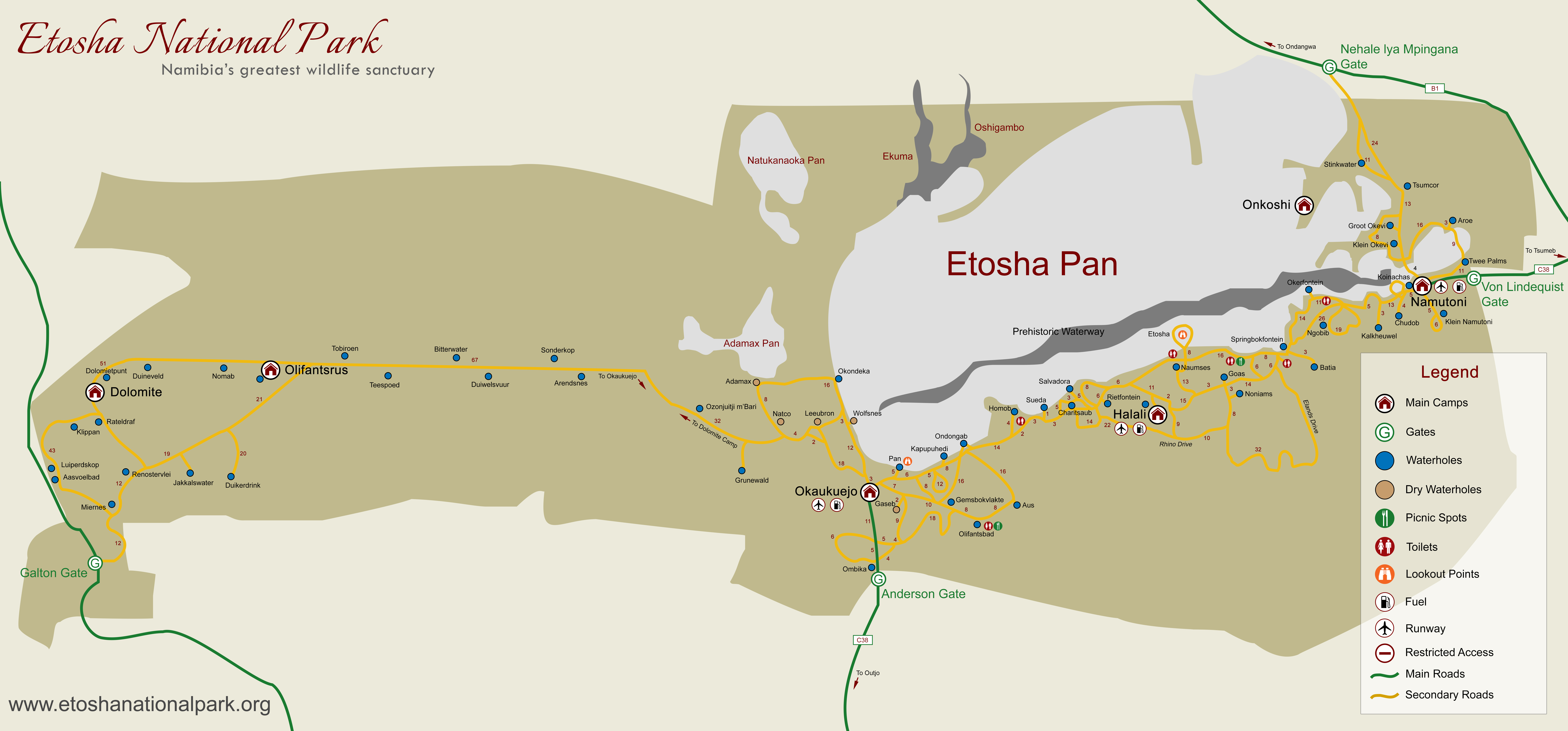
As we left Okaukuejo, we spotted a herd of springbok near the road. It seemed that the territory of springbok, at least at that time, was mostly around Okaukuejo.
We also saw our first animal from the Big Five list—a rhinoceros. It was far away, but later we saw another one up close, so I wont show a picture here.
On our way to Namutoni, we encountered various animals, including ostriches, zebras, and giraffes. Upon arrival at Namutoni, we were relieved to find that the water and power were working, and we could stay there. The campsite features a restaurant, a tourist shop, and an illuminated waterhole where we could sit and watch for animals. Unfortunately, nothing came by during our visit.
We also explored the campsite, which has a notable structure—Fort Namutoni, a fort built in the early 1900s by the Germans during their colonial rule. The fort was destroyed after locals attacked it. It was restored in the 1950s and now serves as a lodge and viewpoint for visitors.
Later in the night, the washroom area became a nightmare. Someone had left the door open, the lights on, and it was swarming with insects. There were so many grasshoppers in front of the door that they started jumping on us the moment we tried to enter. Inside, the place was filled with various creepy and dead insects. It was so bad, it still haunts my dreams.
A key tip for Etosha is to start driving early in the morning and take a break around noon. Animals don’t move much during the peak heat of the day. On our first day, from noon until about 3 p.m., we didn’t see much. On the second day, we got started earlier ans as such seen much more.
In the afternoon of the second day. We saw our second Big Five animal—a herd of elephants crossing the road right in front of us. It was an incredible sight!
Not long after, it started raining heavily. The rain was so intense, visibility was reduced to only 10 meters in front of the car. At one point, a kudu suddenly jumped in front of us, and we narrowly avoided hitting it.
When we returned to the campsite, it was basically underwater due to the rain. We couldn’t cook, and the restaurant was already closed. So, we went to a small supermarket in the camp, bought crackers, and ate them with the leftover cheese. The only comfort was knowing that the next day we’d have an all-you-can-eat buffet at the next campsite.
On our third and final day in Etosha, we got up early once again and started driving around, hoping to spot a few more animals before we left, which we did, on exiting nation cal we saw a rhinoceros with babies. Unfortunately, we didn’t manage to see any lions or leopards, which were probably located further west from Okaukuejo, an area we didn’t get to explore. However, we were still happy with the variety of animals we’d seen. Reflecting back to the second day of our trip when a German tourist warned us that they themselves hadn’t seen any Big Five animals during their three day visit, we came away pretty good.
Our stop for the third day was the Sachsenheim Guest Farm. Their main business is farming, but they also offer accommodations as a side job. The farm had an excellent all-you-can-eat buffet, with German-style food and unlimited drinks.
Day 12-13: Waterberg Plateau
We’ve reached the final major section of our Namibia trip: the Waterberg Plateau, a landscape marked by table mountains. These are distinctive, flat, elevated landforms, nearly level at the top. The plateau is home to many plant species, abundant birdlife, and another Big Five animal—the buffalo.
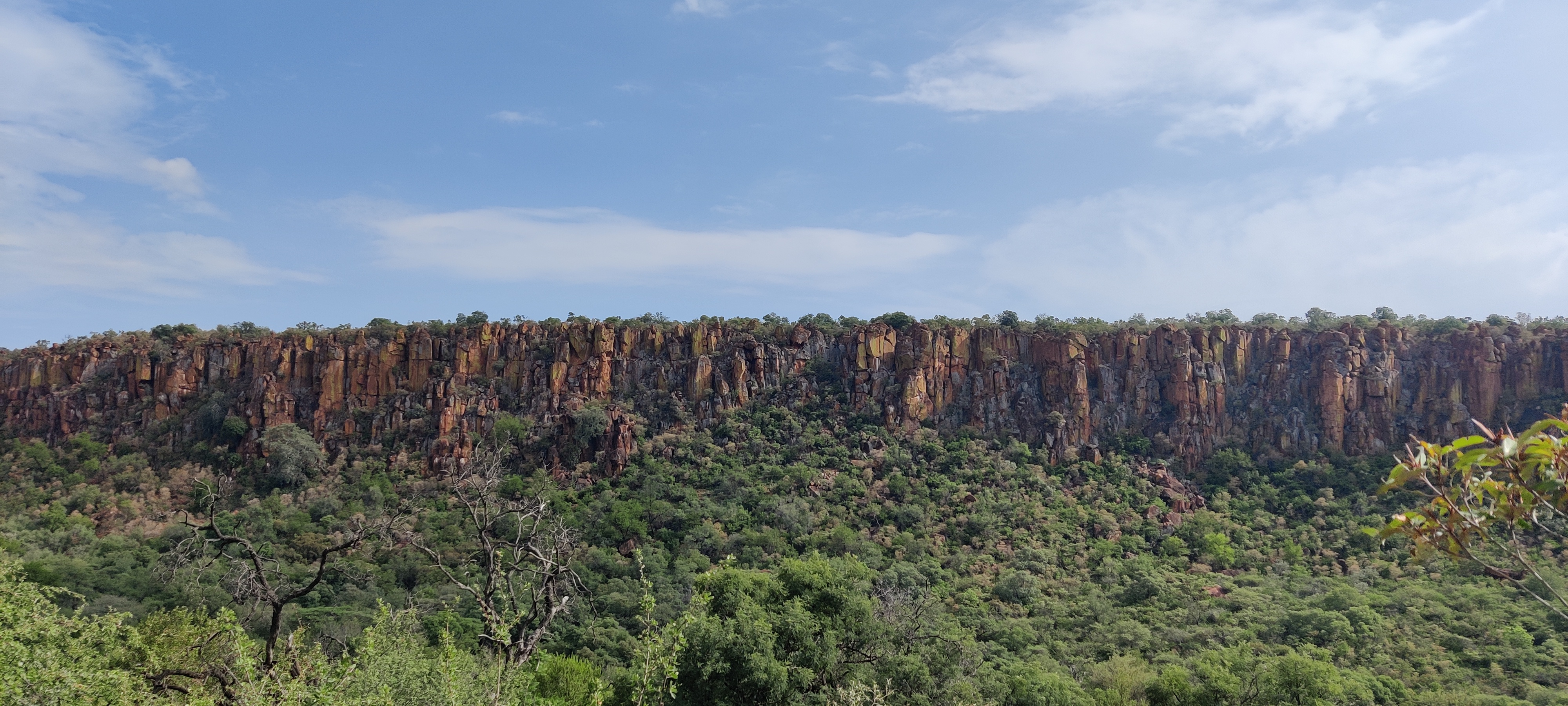
Before we arrived at the plateau, we made one final stop at the world’s largest meteorite: Hoba. To get close to the meteorite, you need to pay a fee of 15€, which honestly feels a bit overpriced, given that the whole visit lasts about five minutes. You simply look at the meteorite, take a few photos, and that’s it. There is always someone there making sure no one damages it. Two interesting things to note: first, one can see parts of the meteorite that have been damaged because people used to break off pieces as amulets. Second, if you stand on top of the meteorite in the middle and speak, it echoes, as the meteorite is almost entirely made of metal. It’s pretty wild that they let you stand on top of it in the first place.

After that brief visit, we continued to our next stop: the Waterberg campsite. The campsite offers several hiking routes. Since it was already afternoon, we opted for the shortest one—the History Path, which is 2.2km long. This path features information about the 1904 Waterberg battle between German colonial forces and the Herero people, as well as the subsequent events. There are more hiking routes, but none lead up to the plateau. To hike up to the plateau, you need to book a guided tour (400 Namibian dollars), which has to be reserved at least one day in advance, so we missed out on that.
What’s special about Waterberg Plateau is that it stays green year-round, unlike most other places in Namibia. However, since we were in Namibia during the rainy season (the off-season), and we had already seen Etosha in its lush green state, it wasn’t as striking as we expected.
In the evening, just as it was getting dark, a monkey appeared at our campsite, probably drawn by the smell of food. Later, after we were in our tents, a honey badger came by and knocked over our trash can. Waterberg has many monkeys, so it’s advised not to leave anything unattended that they might steal, and always keep the car and tent closed.
One thing I really appreciated about the campsite was that each lot had its own toilet and shower. Compared to the campsite in Etosha, these facilities were incredibly clean—pure bliss!
The next day, since we had missed the guided tour to the top of the plateau, we decided to explore the remaining hiking routes. We hiked the Dassie Trail (3.2km), Foundation Trail (1.0km), Porcupine Highway (1.0km), and Anderson Trail (2.8km). There was another trail, the Giraffe Crossing (5.8km), but it was closed due to the rain in the previous days.

Originally, we had planned to eat at a lodge for dinner, but when we arrived, we were told we needed to register a day in advance. Unfortunately, we had already thrown away most of our food in preparation for our departure the next day. So, we went to the reception, where they sold us some frozen meat, which we fried in a pot of oil over our camping gas cooker.
Day 14: On Our Way Back
This was the last day of our trip. We made sure the car was clean, packed up all our belongings, and drove back to Windhoek. Before heading there, we made a detour to Okahandja to visit the famous wood market. It’s filled with local stands selling all kinds of wooden crafts, and we picked up some carved animals that we had seen in Etosha as souvenirs.
However, I will say the vibe at the market was a bit strange. As soon as we entered, we were swarmed by around 10 different vendors, all trying to sell us something. We picked the first stand and went there, there aren’t any fixed prices, and instead, everything is negotiable. The vendors will try to take advantage of you, and bargaining is a must. After picking out four wood pieces, the seller took us to a corner of the shop and wrote the price in the sand, probably so that the other shopkeepers couldn’t hear and undercut him. He started with a price of 4500 Namibian dollars (about 220€), and we countered with 450 Namibian dollars. In the end, we showed him that we only had 700 Namibian dollars on us, and he reluctantly accepted, though he took the 5€ piece we had as well.
If you decide to visit, I’d recommend being cautious: don’t take too much money with you and try to bring another person for safety.
On the way into Windhoek, we couldn’t help but notice the big billboards with humorous traffic safety tips, like “Do not speed” or “Do not drink and drive.” I wish I could’ve gotten a picture of them.
In Windhoek, we finally checked off something we had missed on the first day: visiting Joe’s Beerhouse for lunch. It’s one of the most famous restaurants in the city, known for its distinct atmosphere—full of rustic old items hanging around. And I mean that in the best way possible. The food was fantastic. I had lasagna, but with a twist: it was made with game meat. I highly recommend visiting this place. When we went for lunch, it was fairly empty, but by evening, it became quite busy.
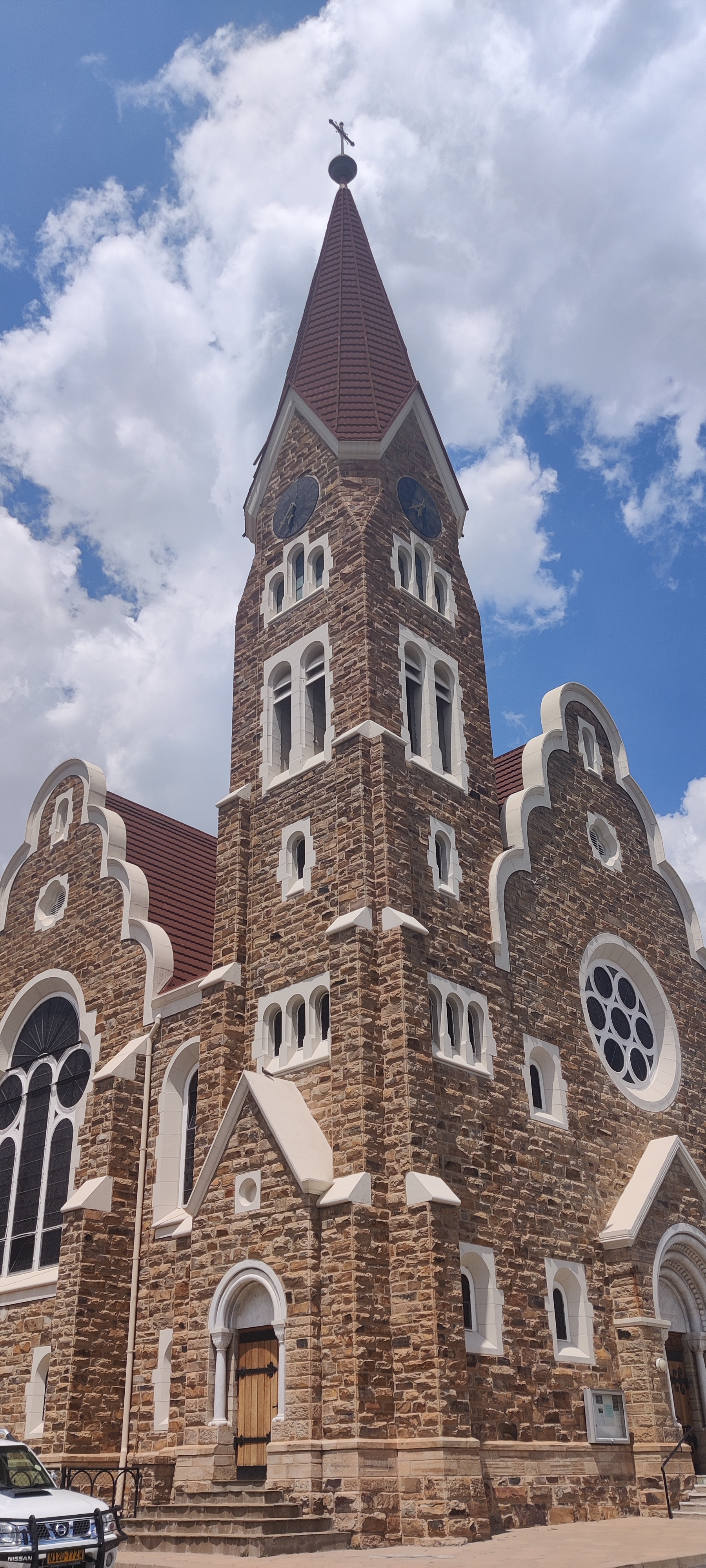
The last thing we did in Windhoek was visit Christ Church, one of the city’s characteristic landmarks. Unfortunately, it was closed when we arrived, but it looked swell from the outside. It was amusing to see that the church’s bulletin board was very German, with something along the lines of, “We invite visitors to our weekly coffee party, where Pastor… will say a few words,” a very German thing.
With that done, we drove to the car rental business to return the car. They didn’t find any issues with it, and shortly after, they drove us to the airport. We were about to fly back on the last plane to Frankfurt, but funny enough, the flight also coincided with Namibia’s National Floorball Team heading to the 2025 Olympics. So we shared our flight with them.
